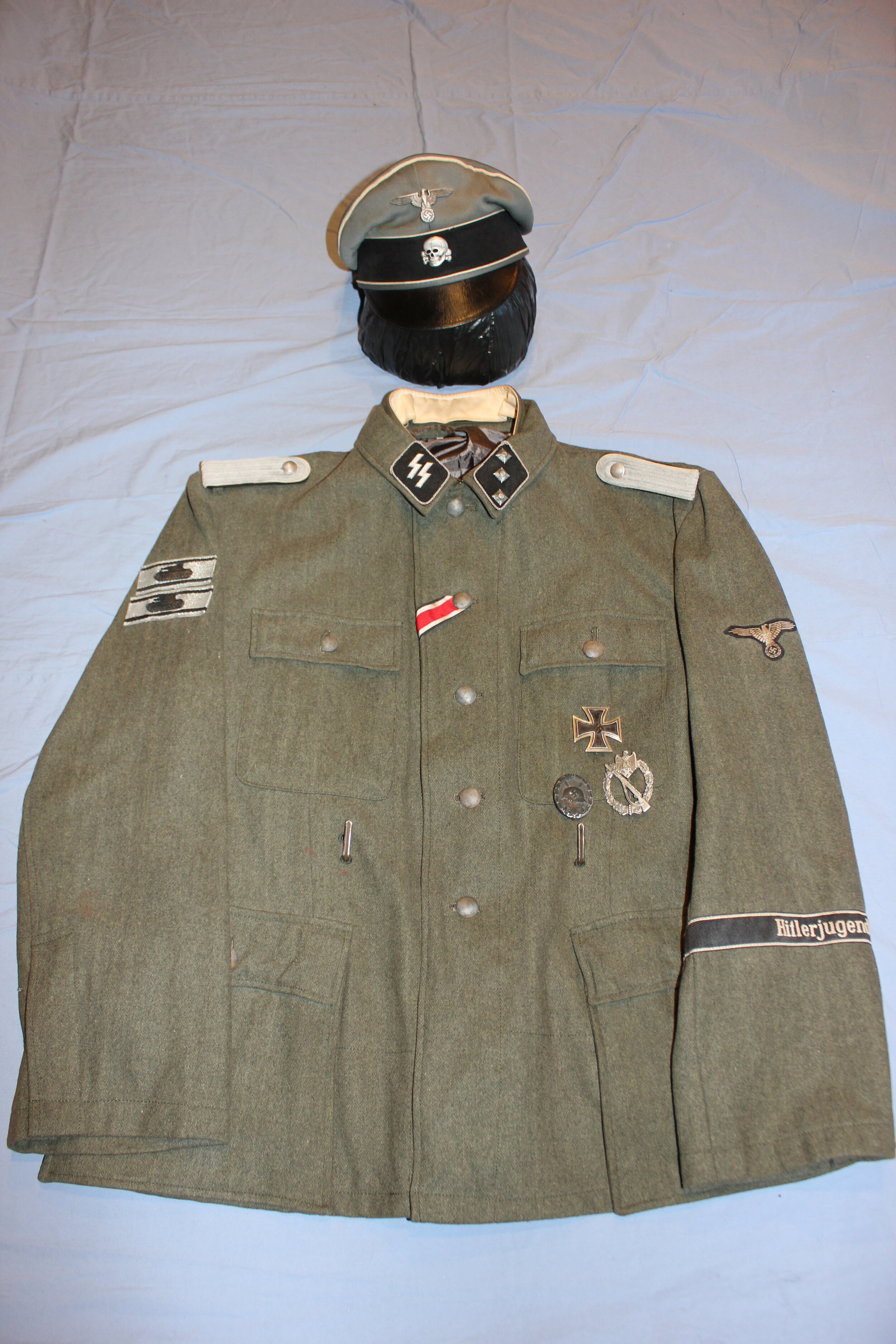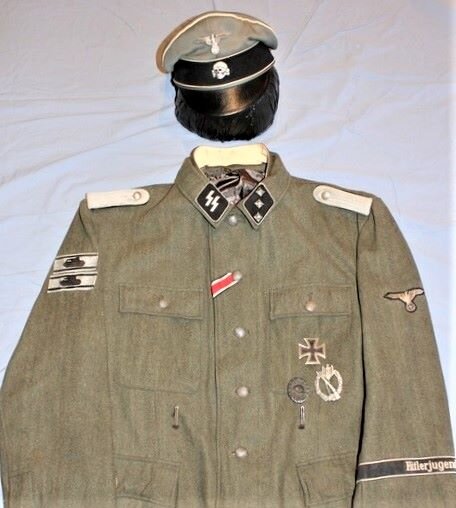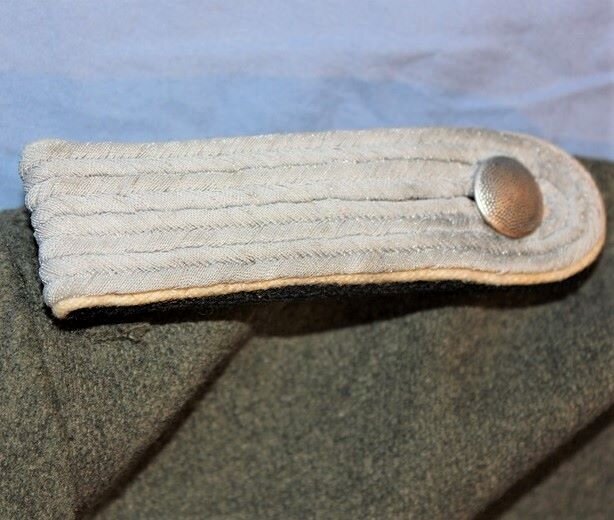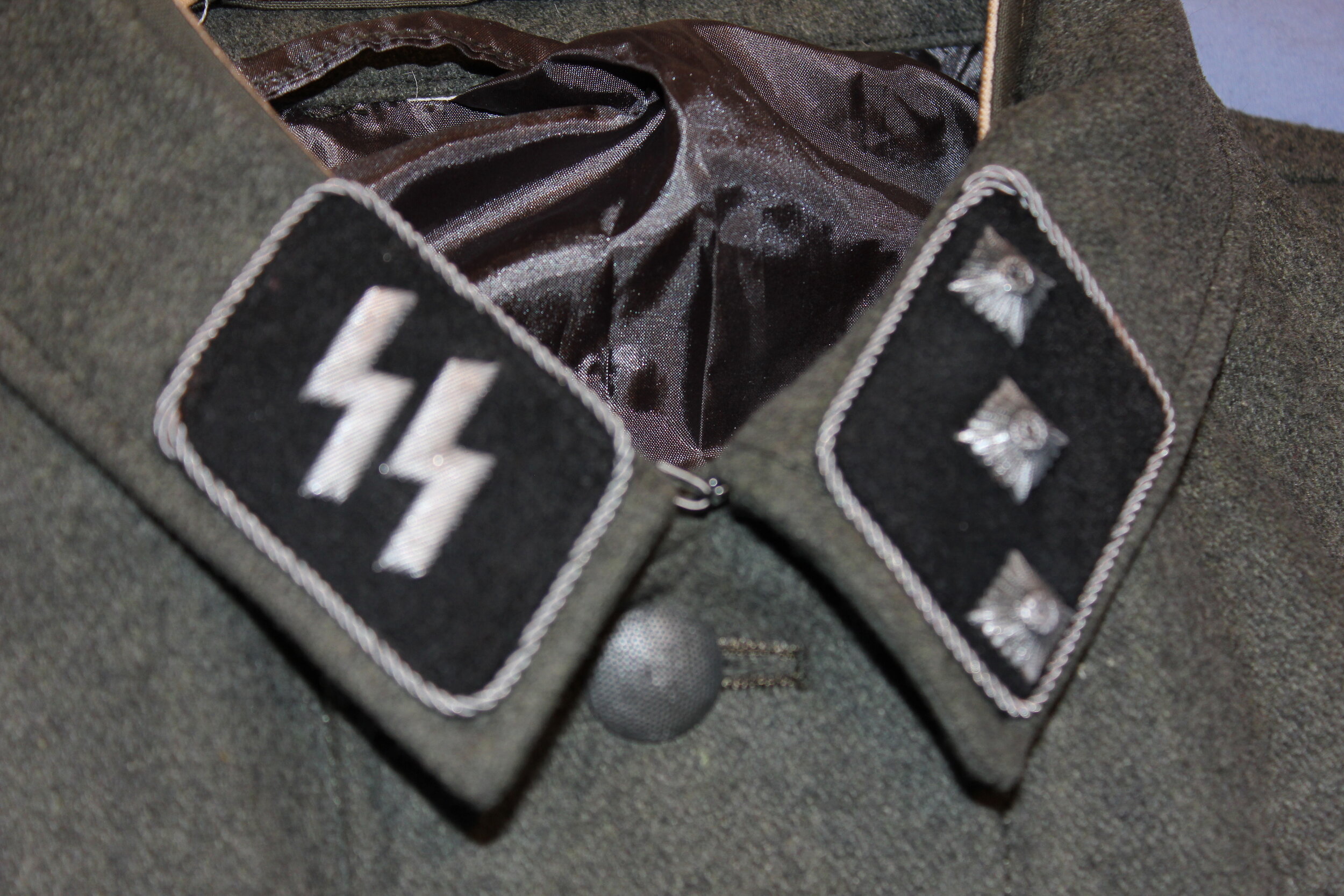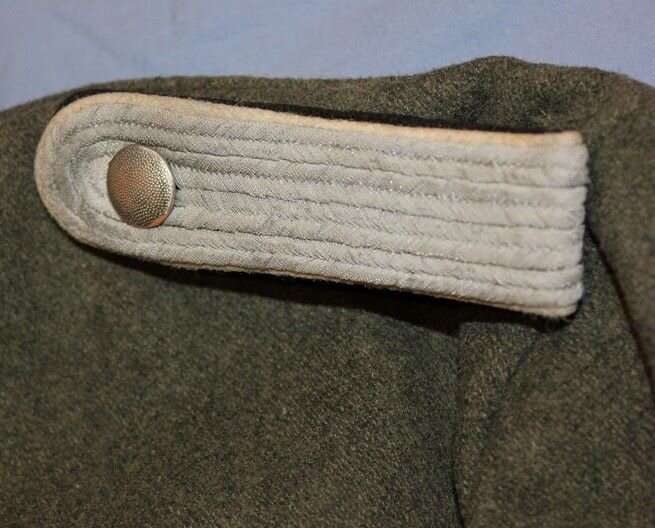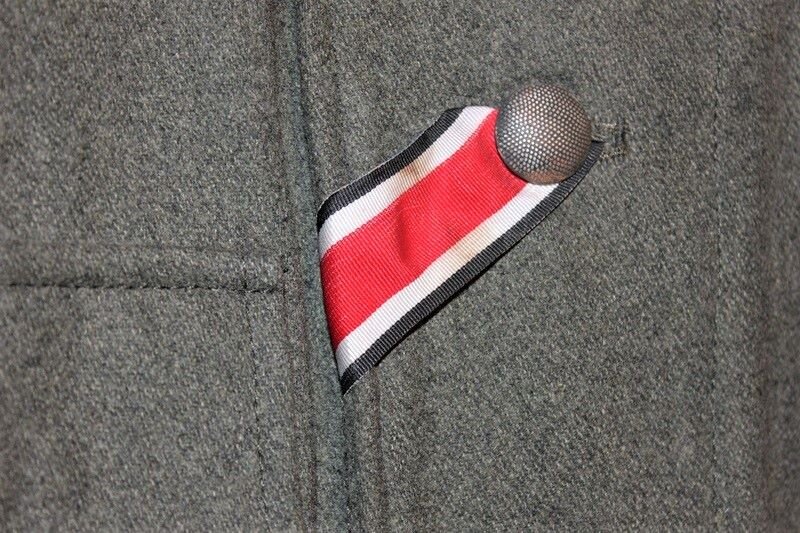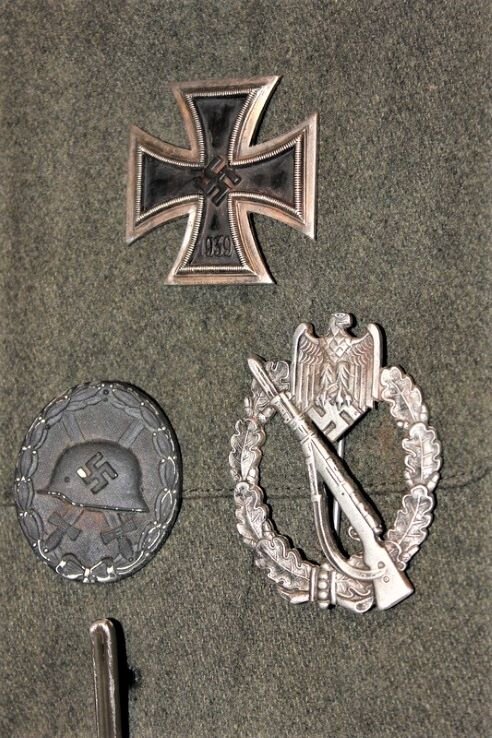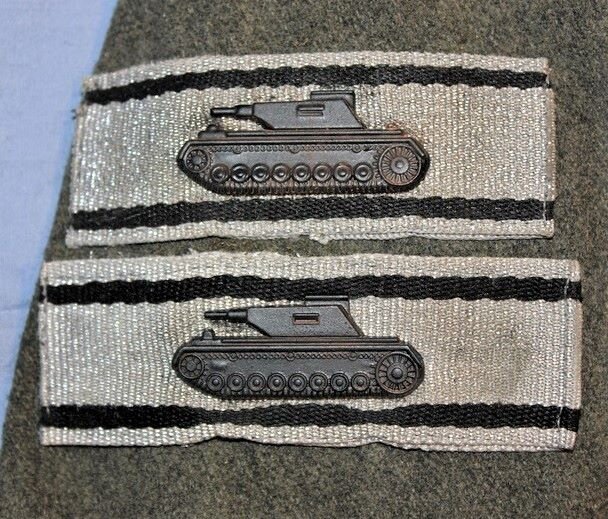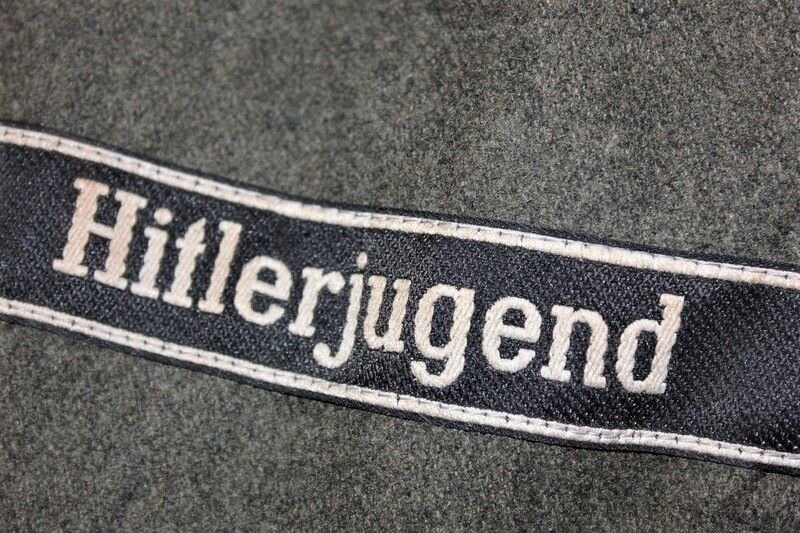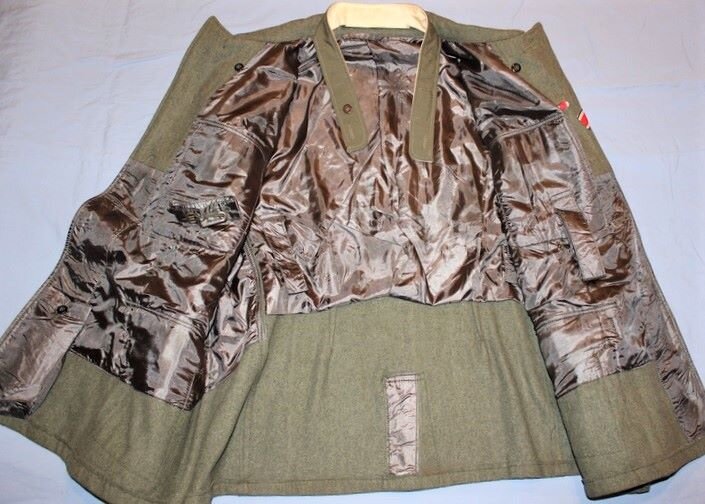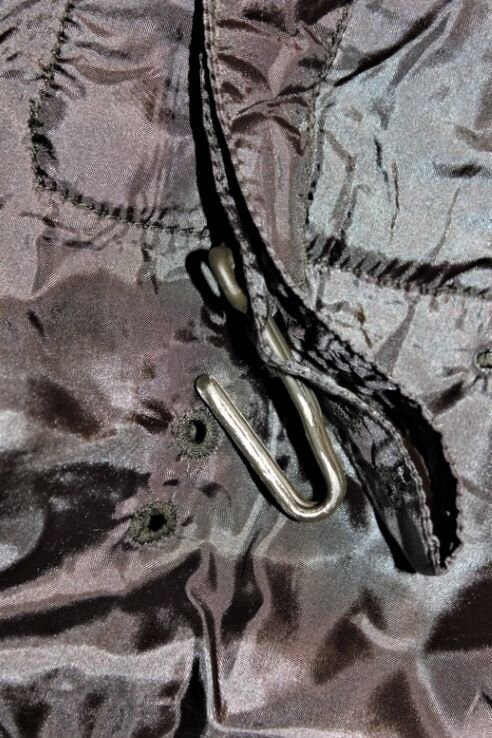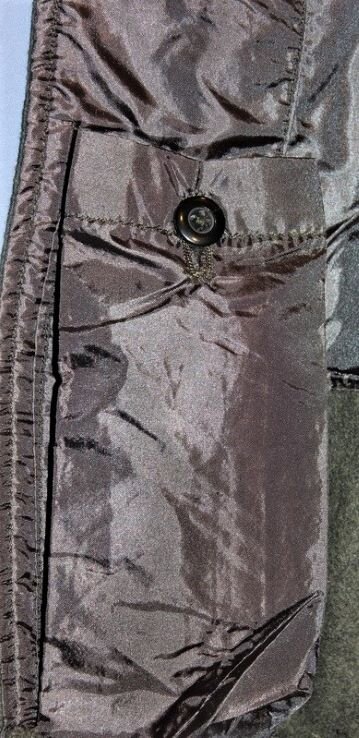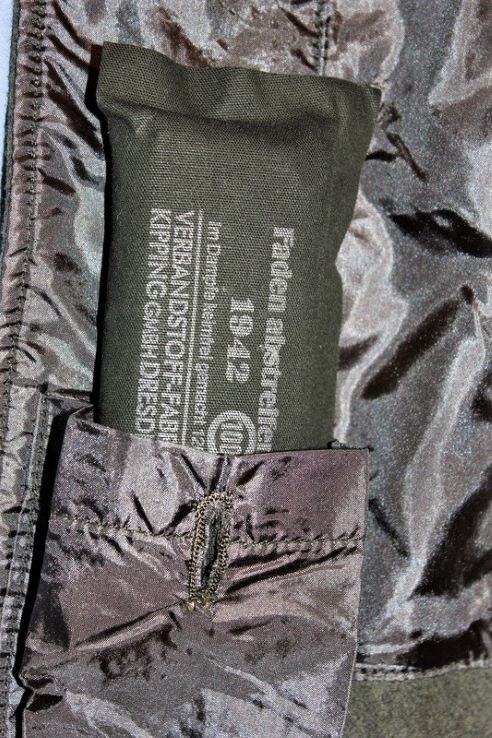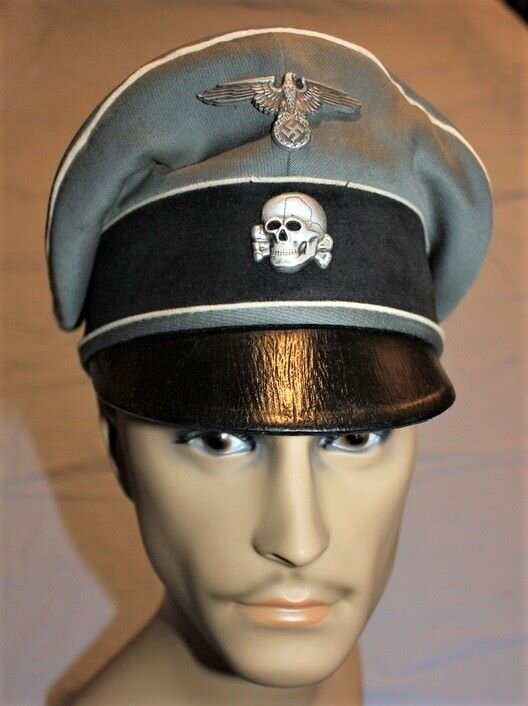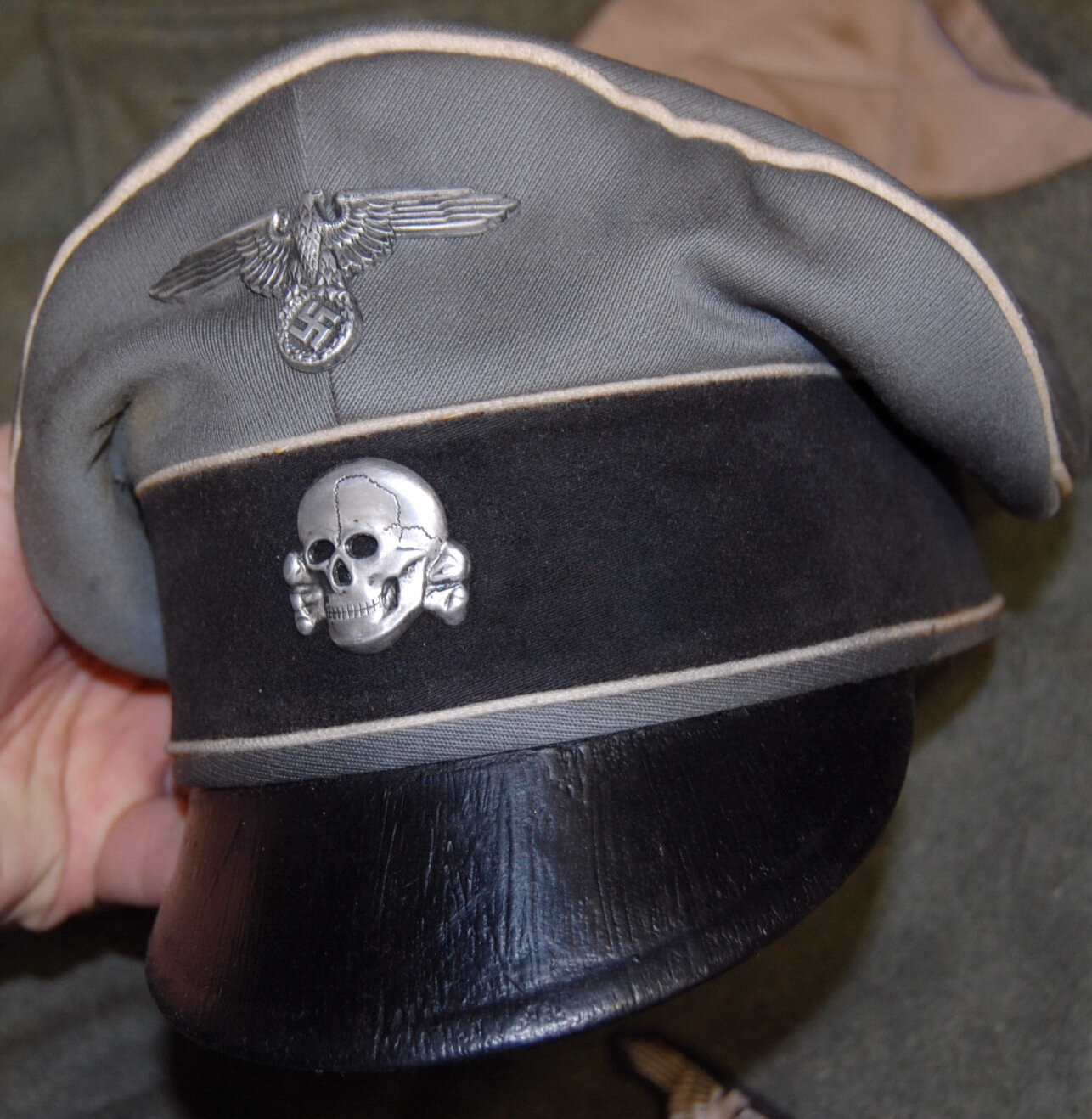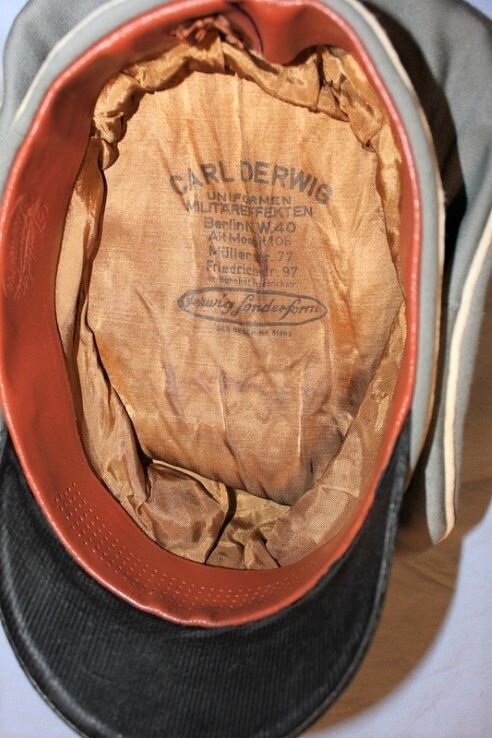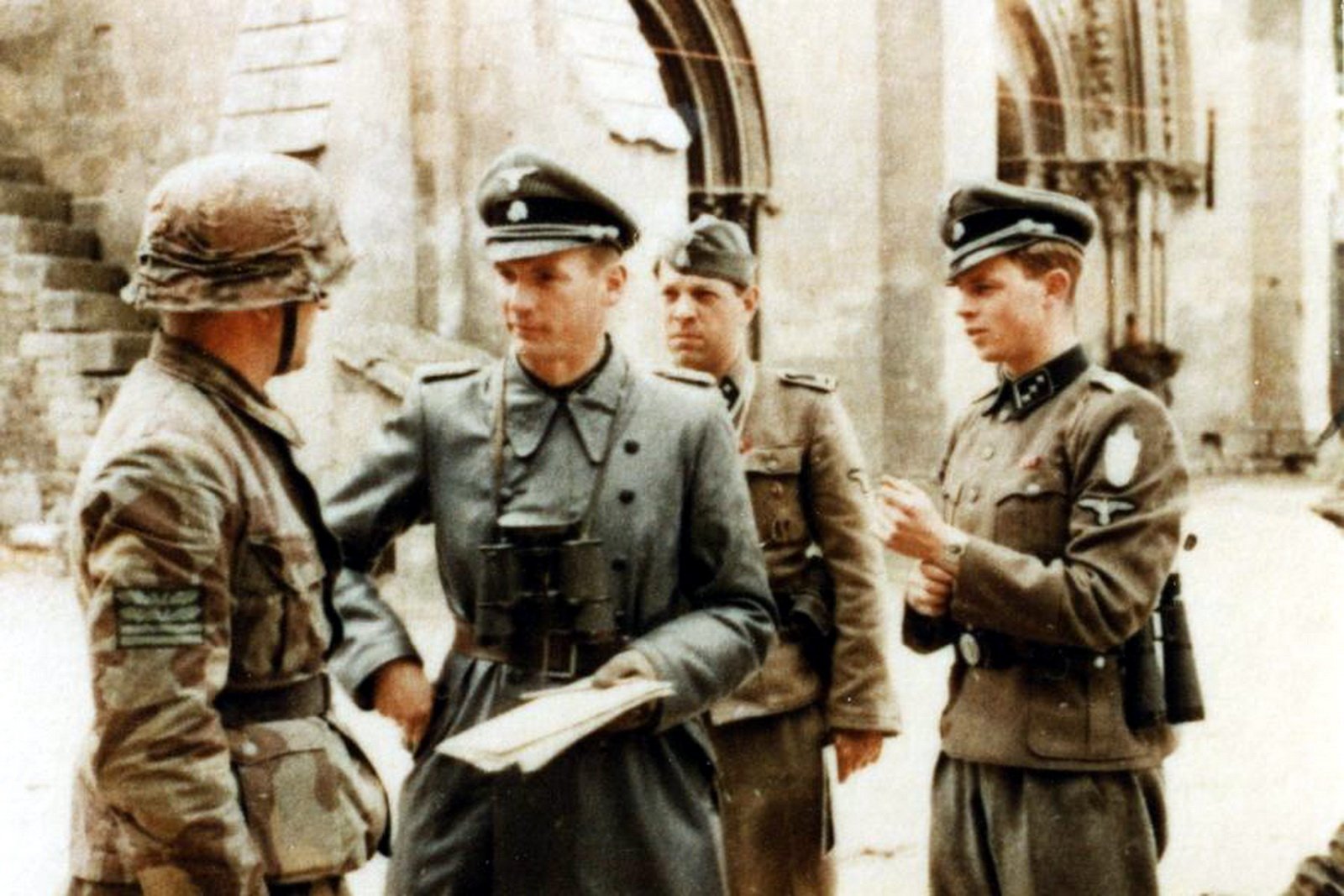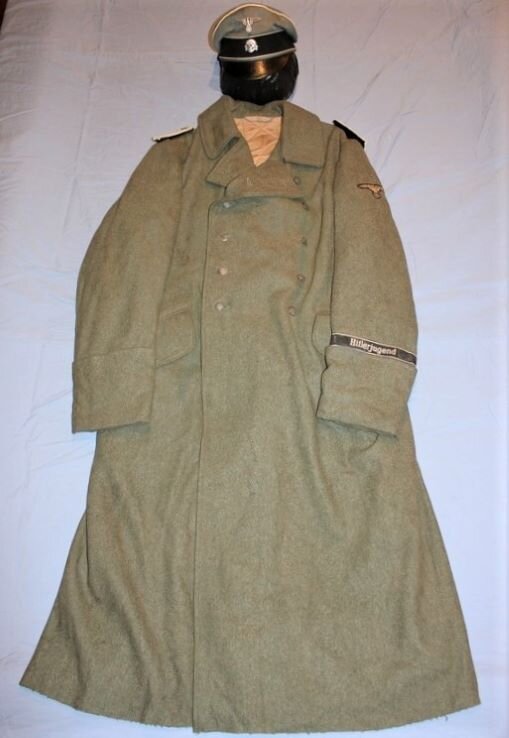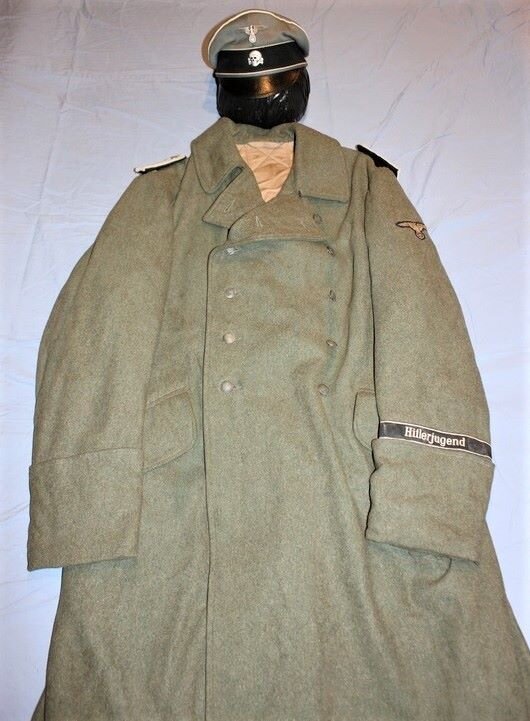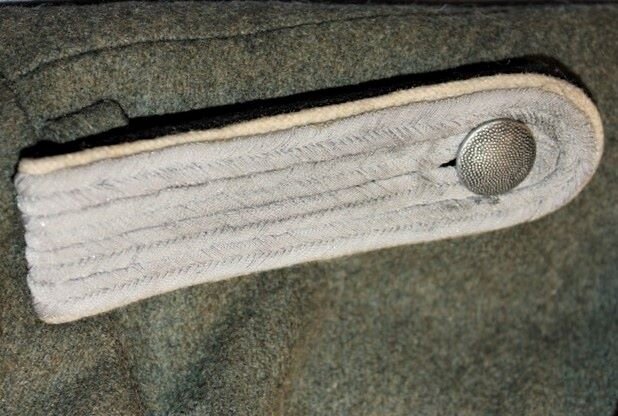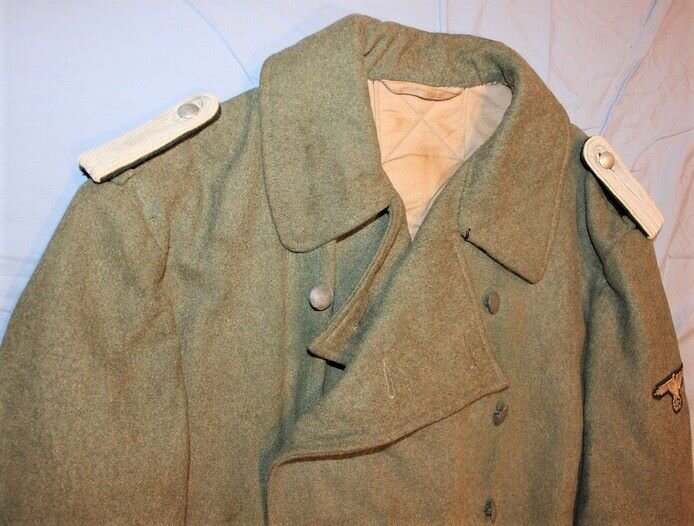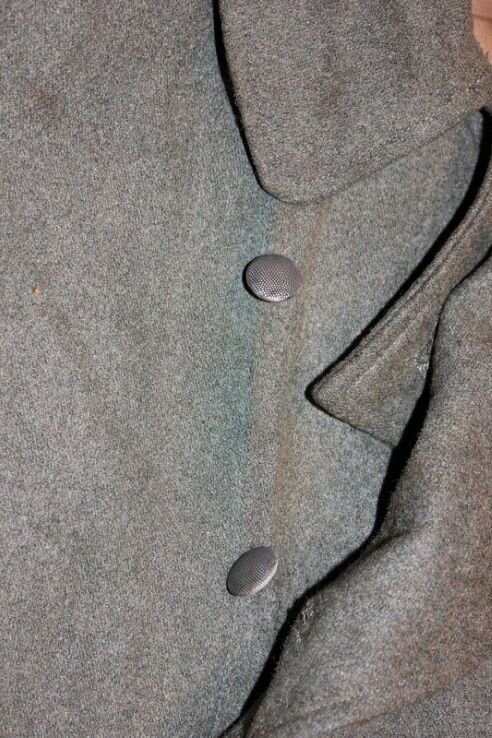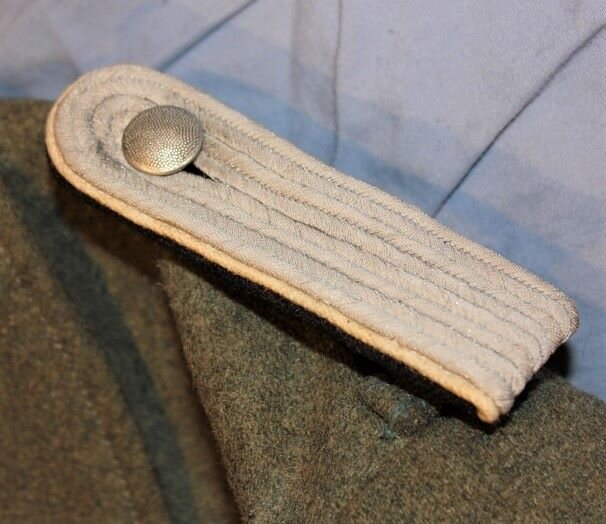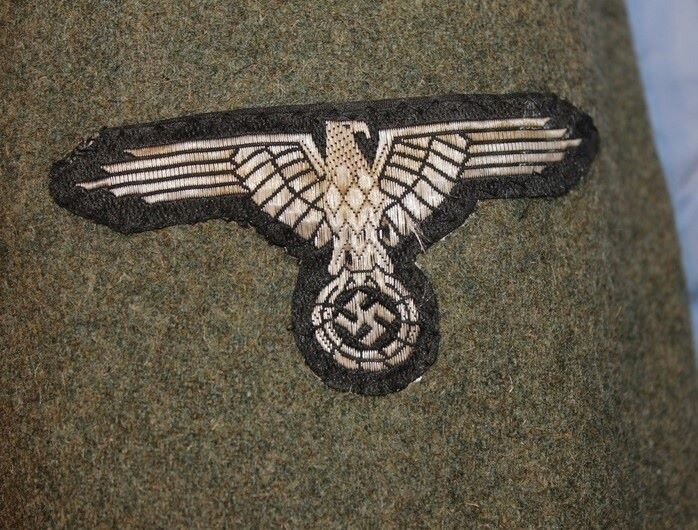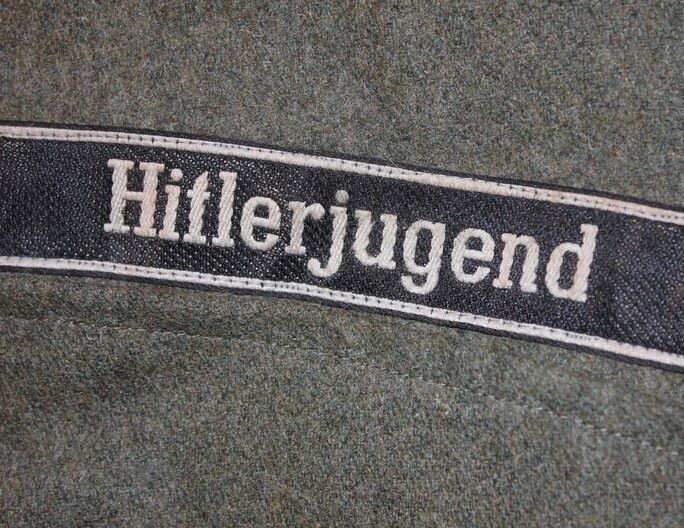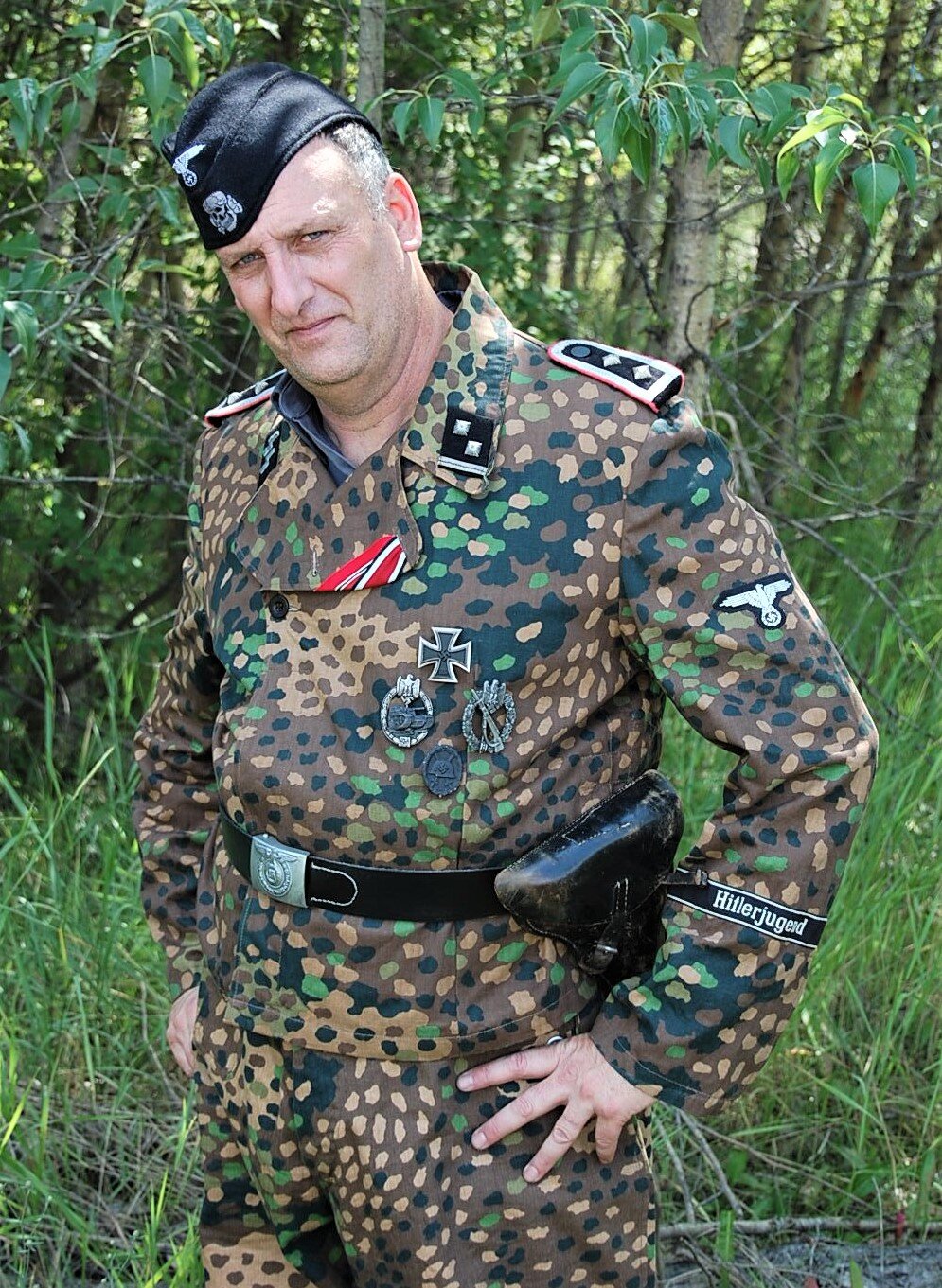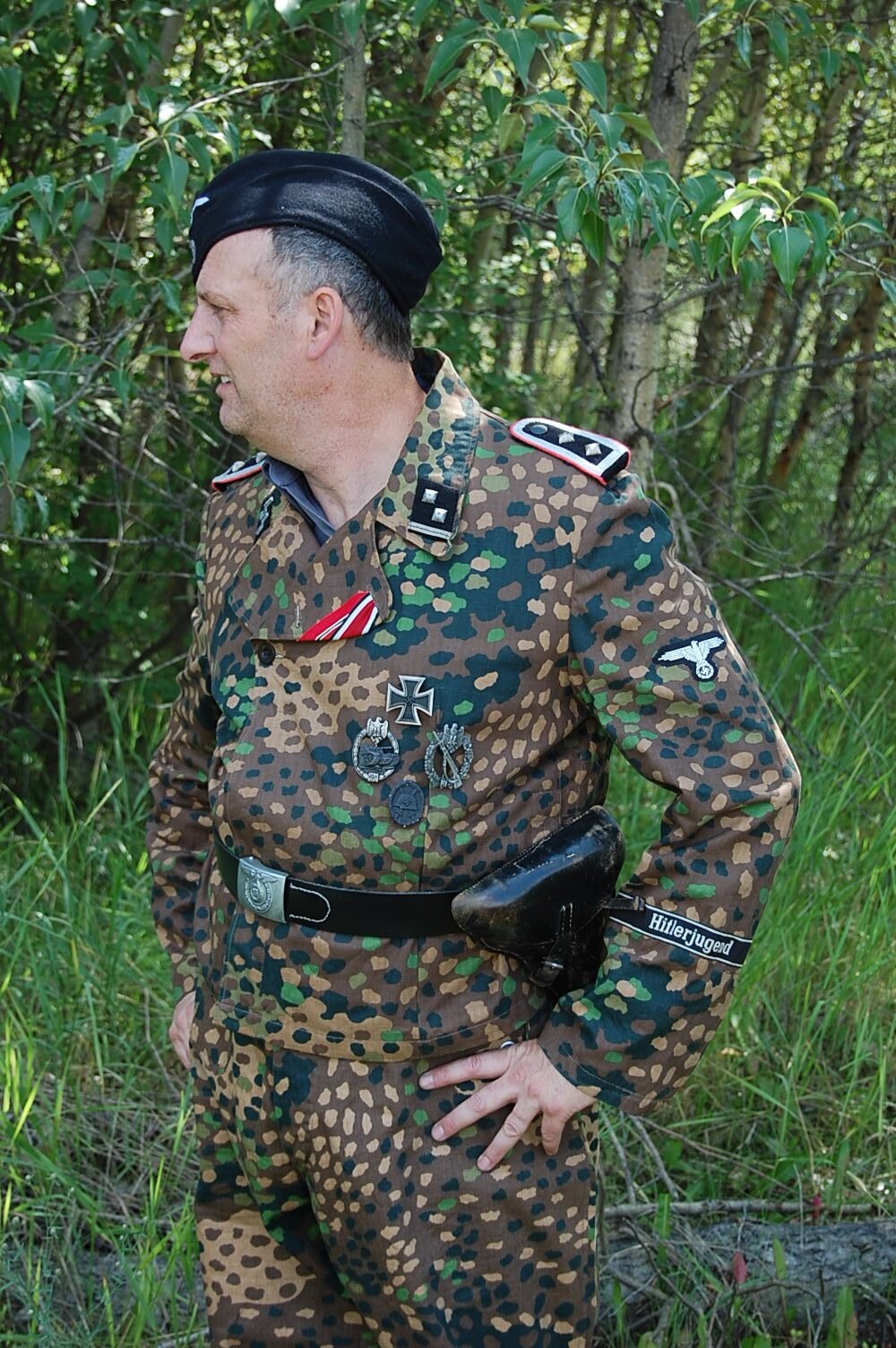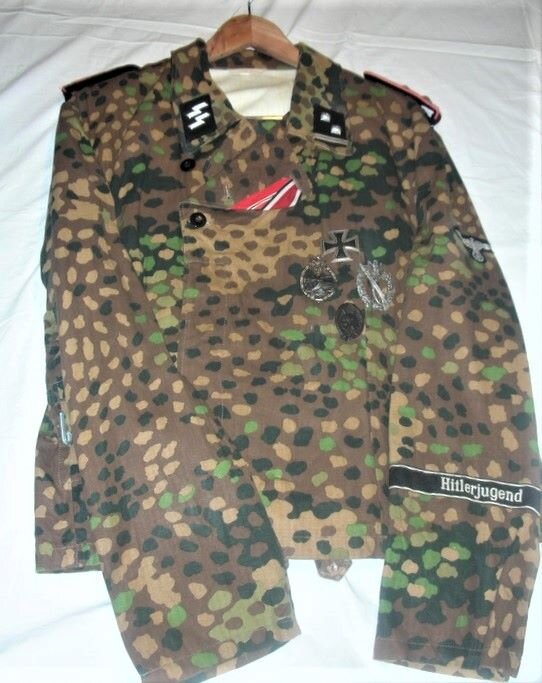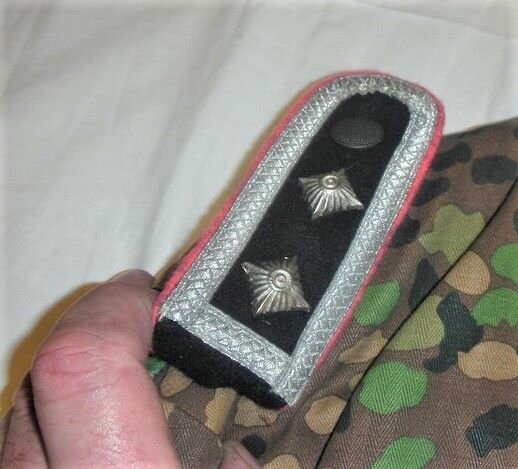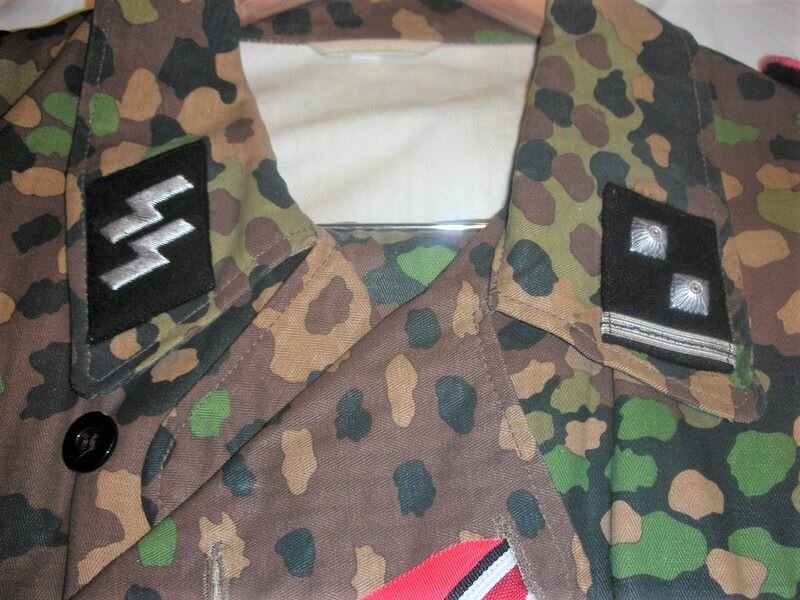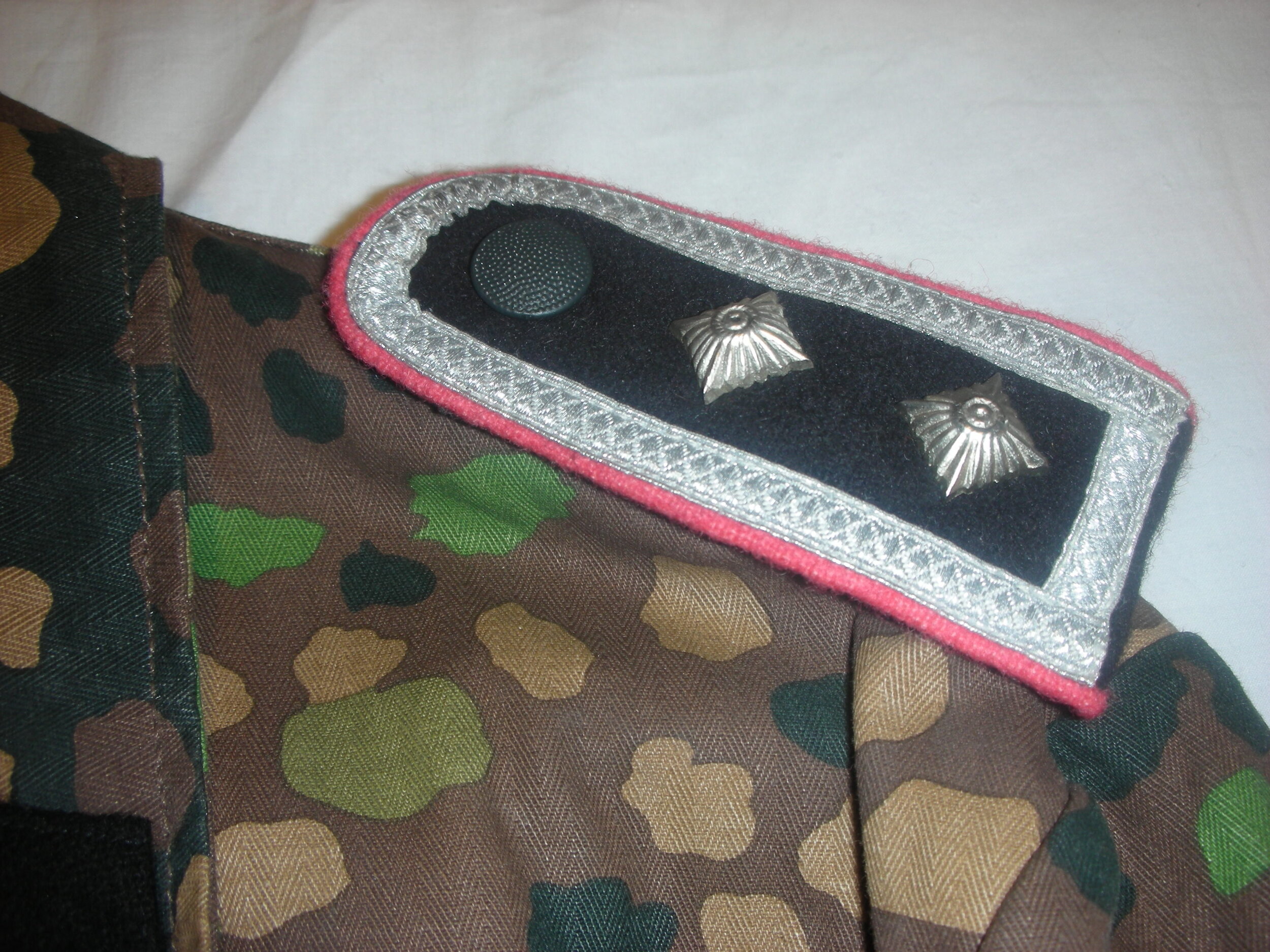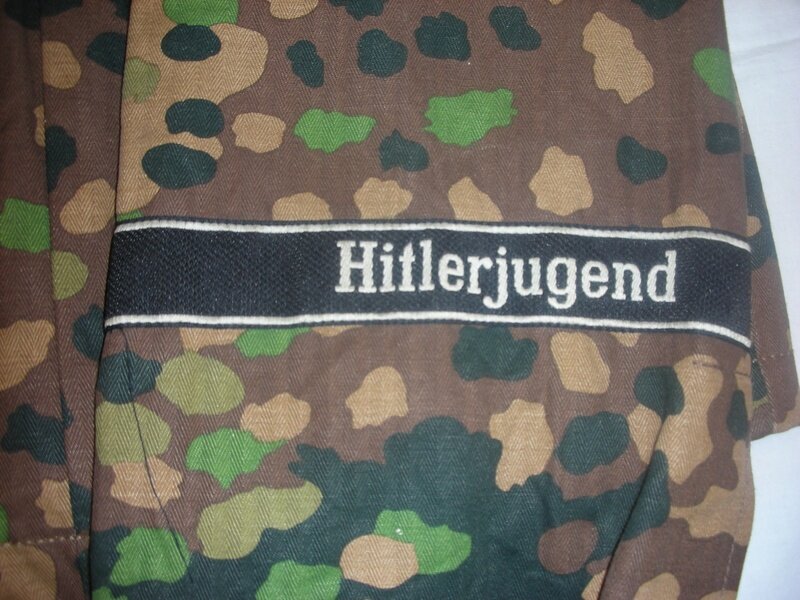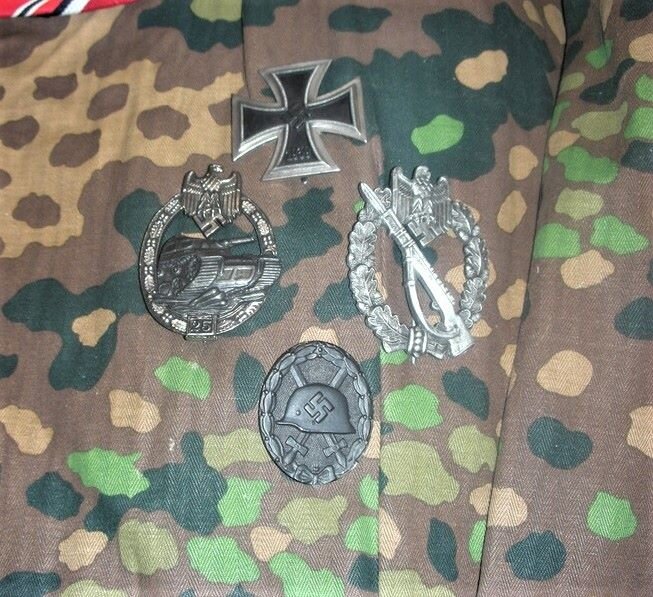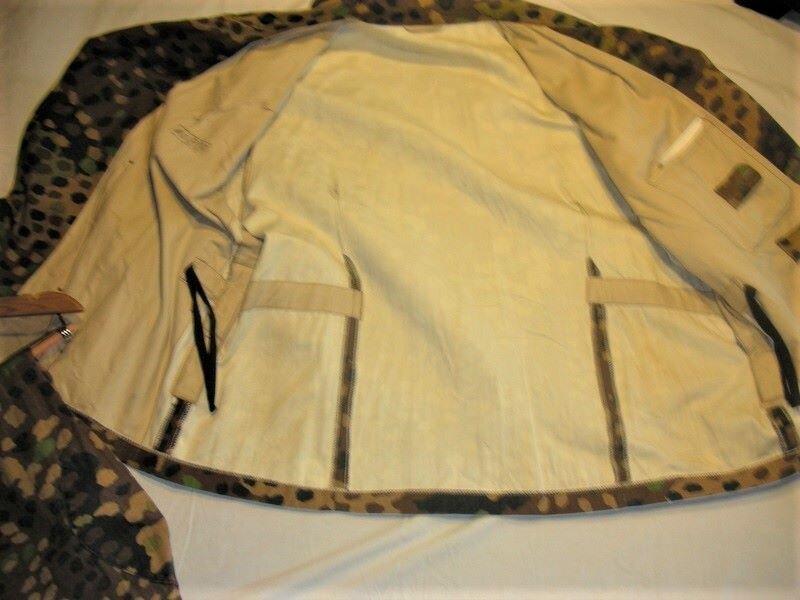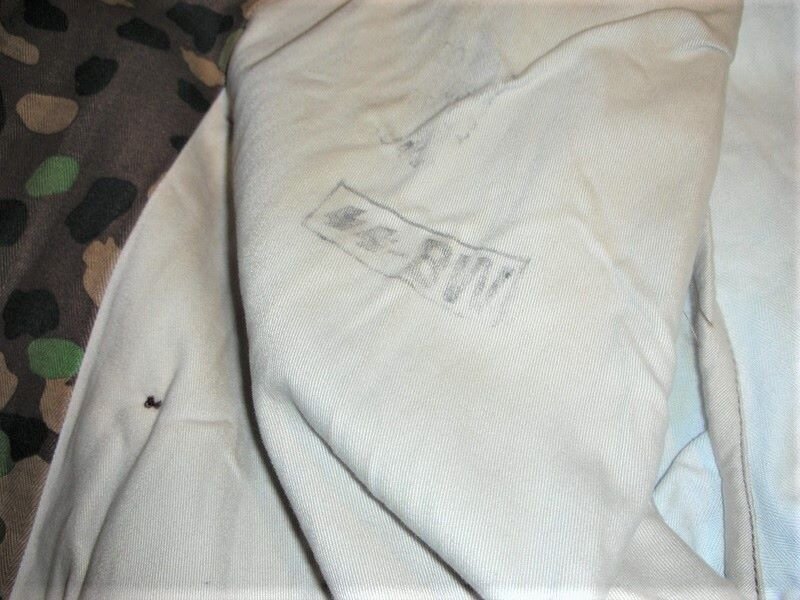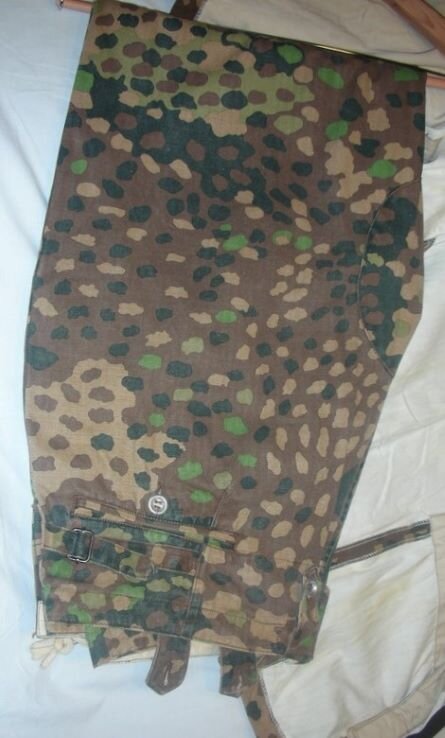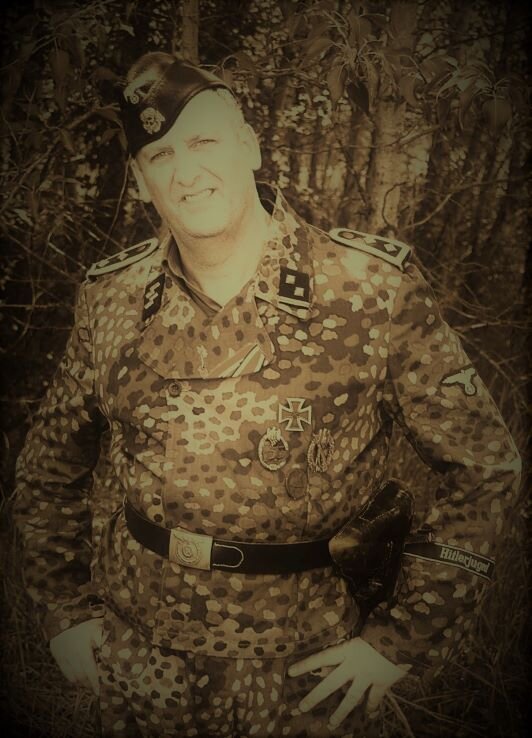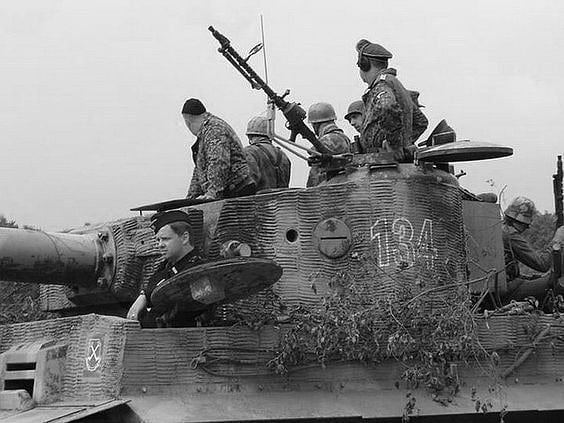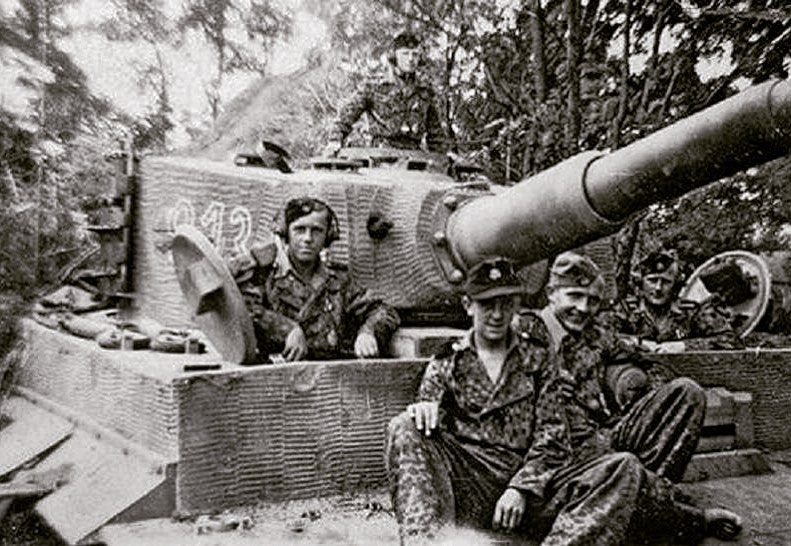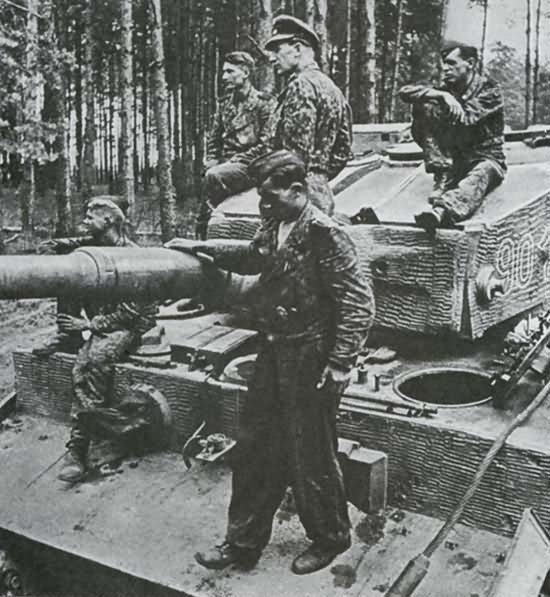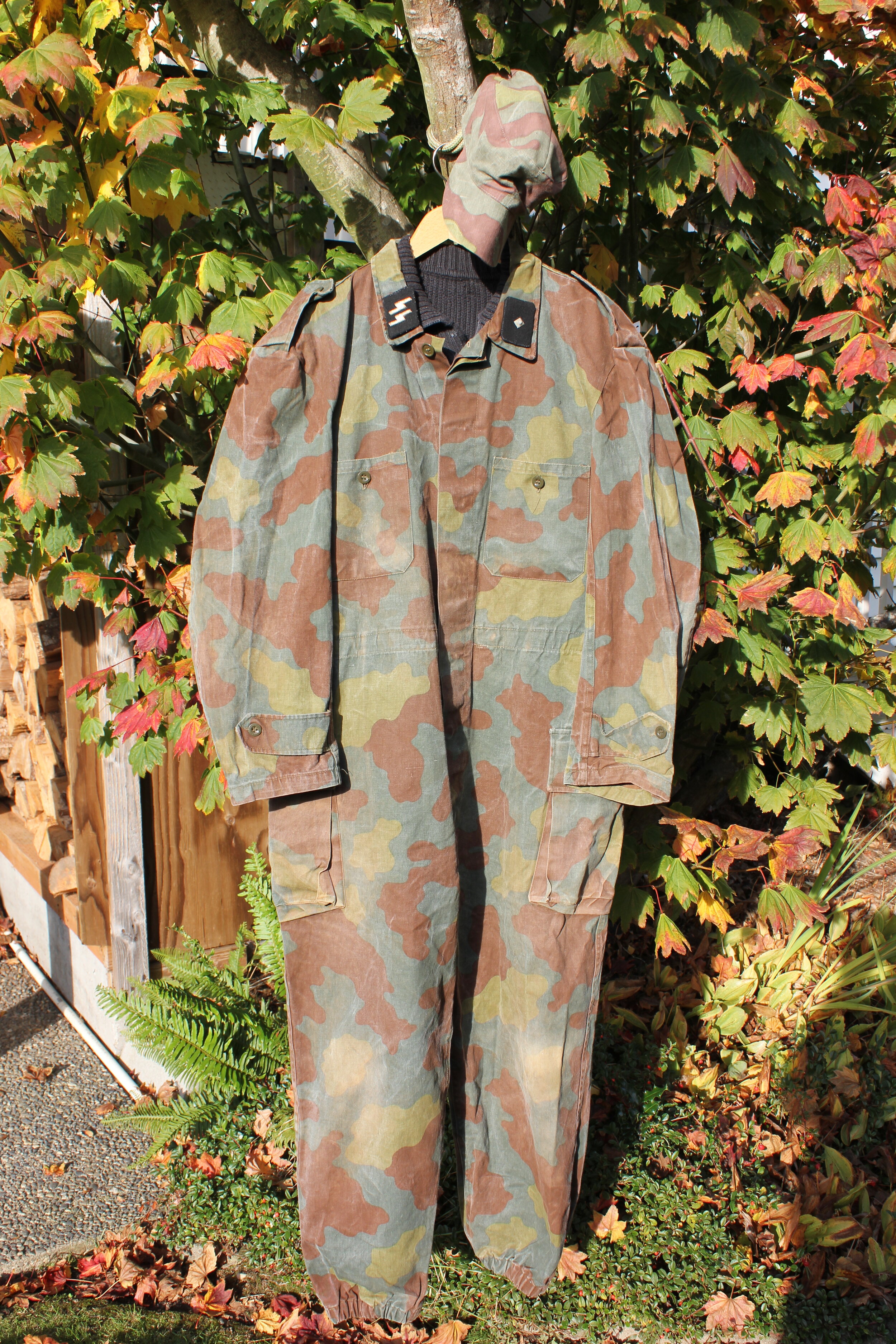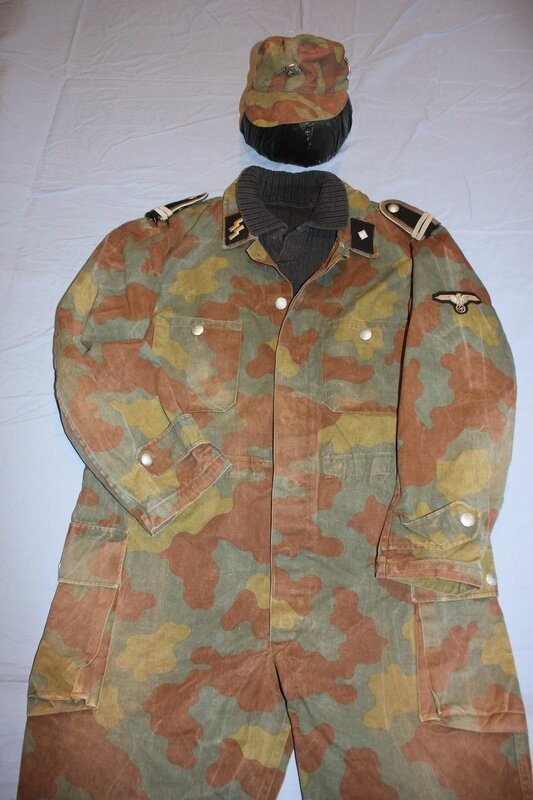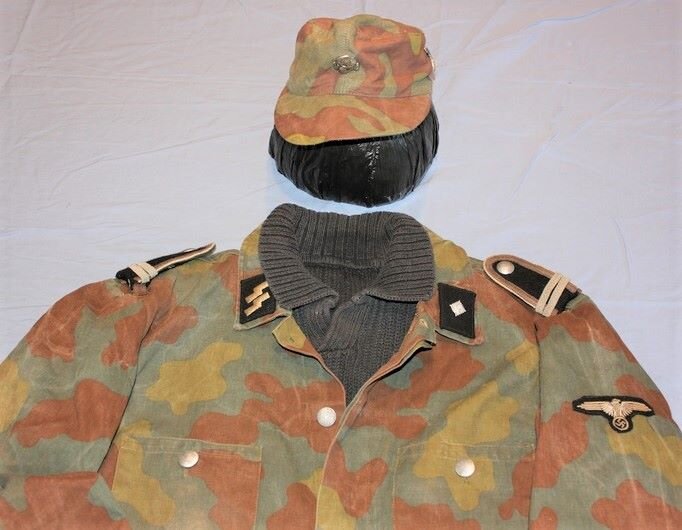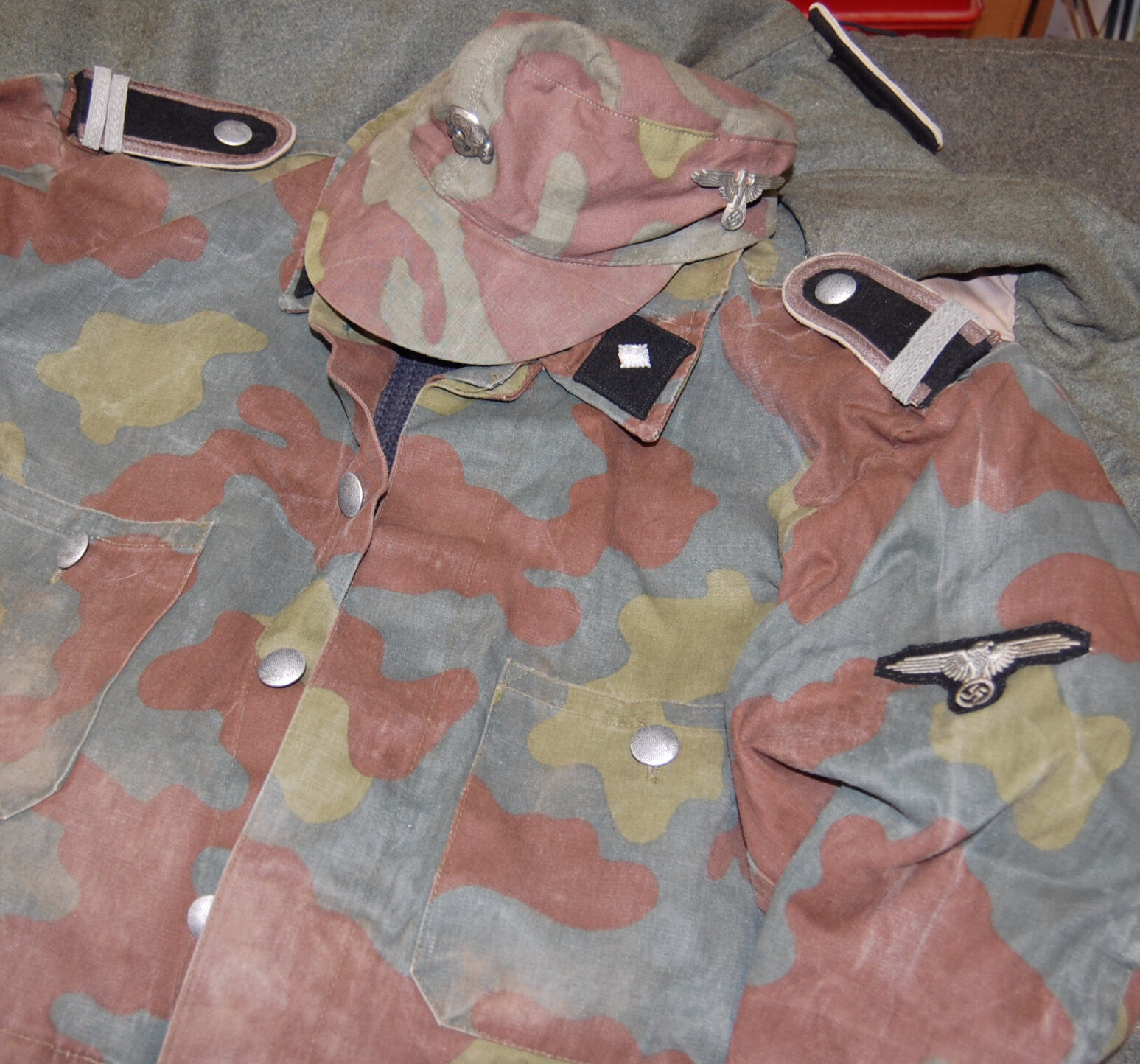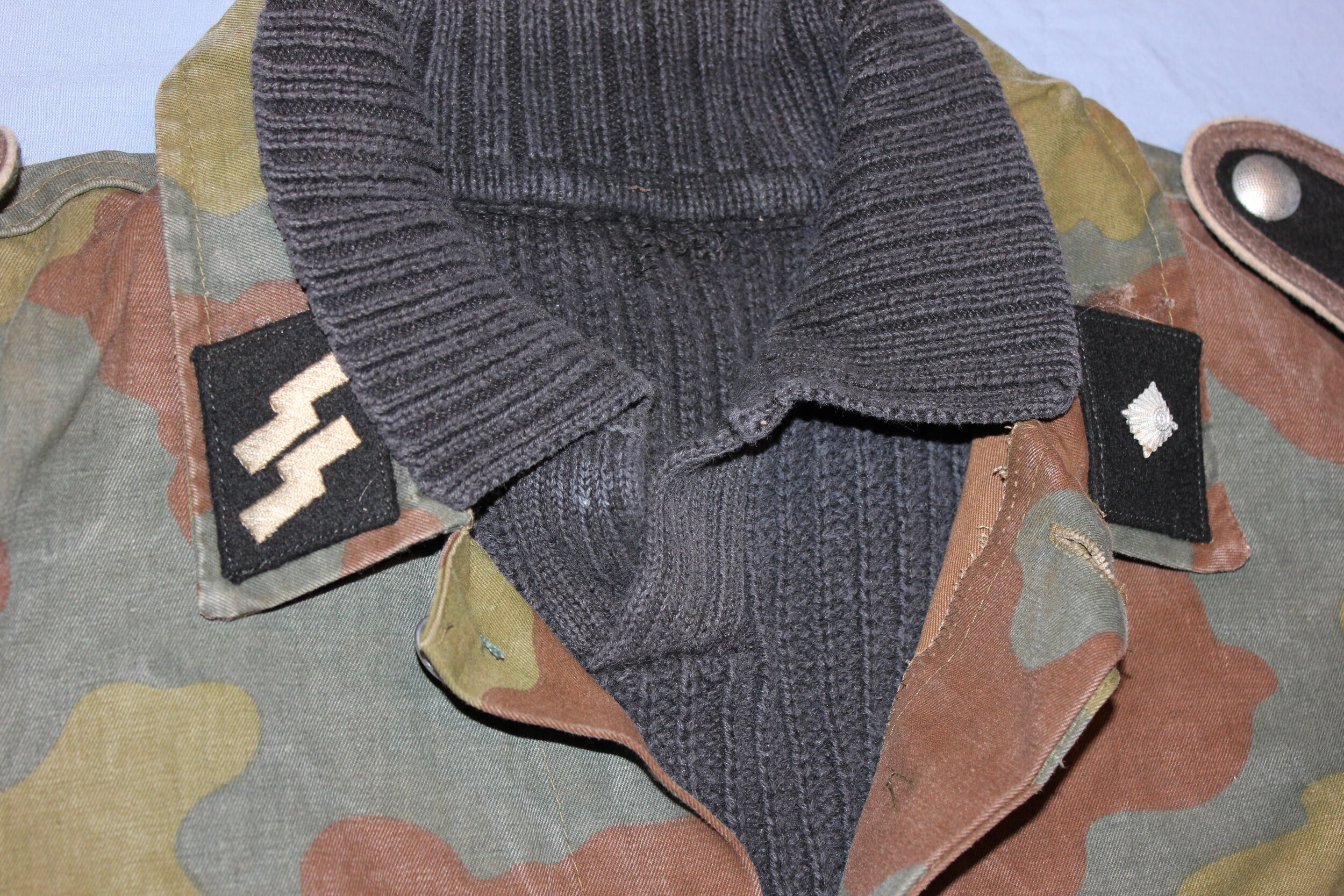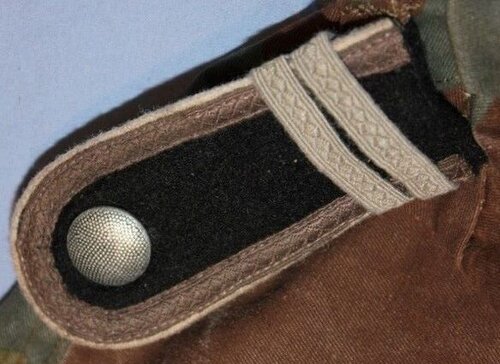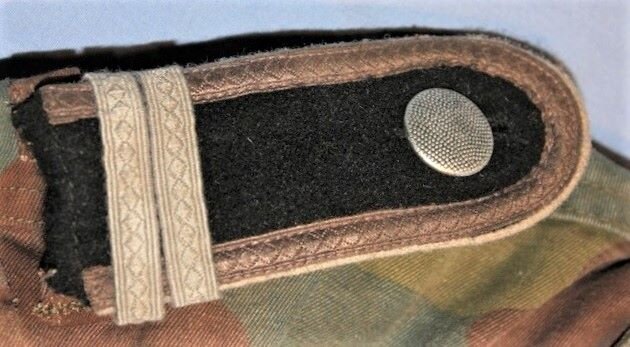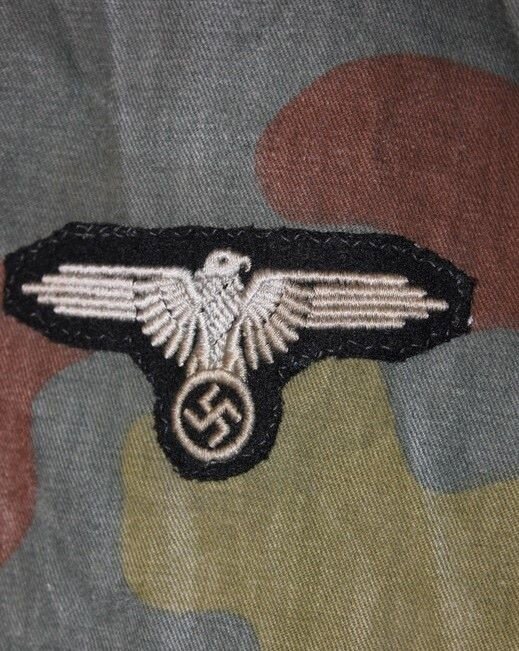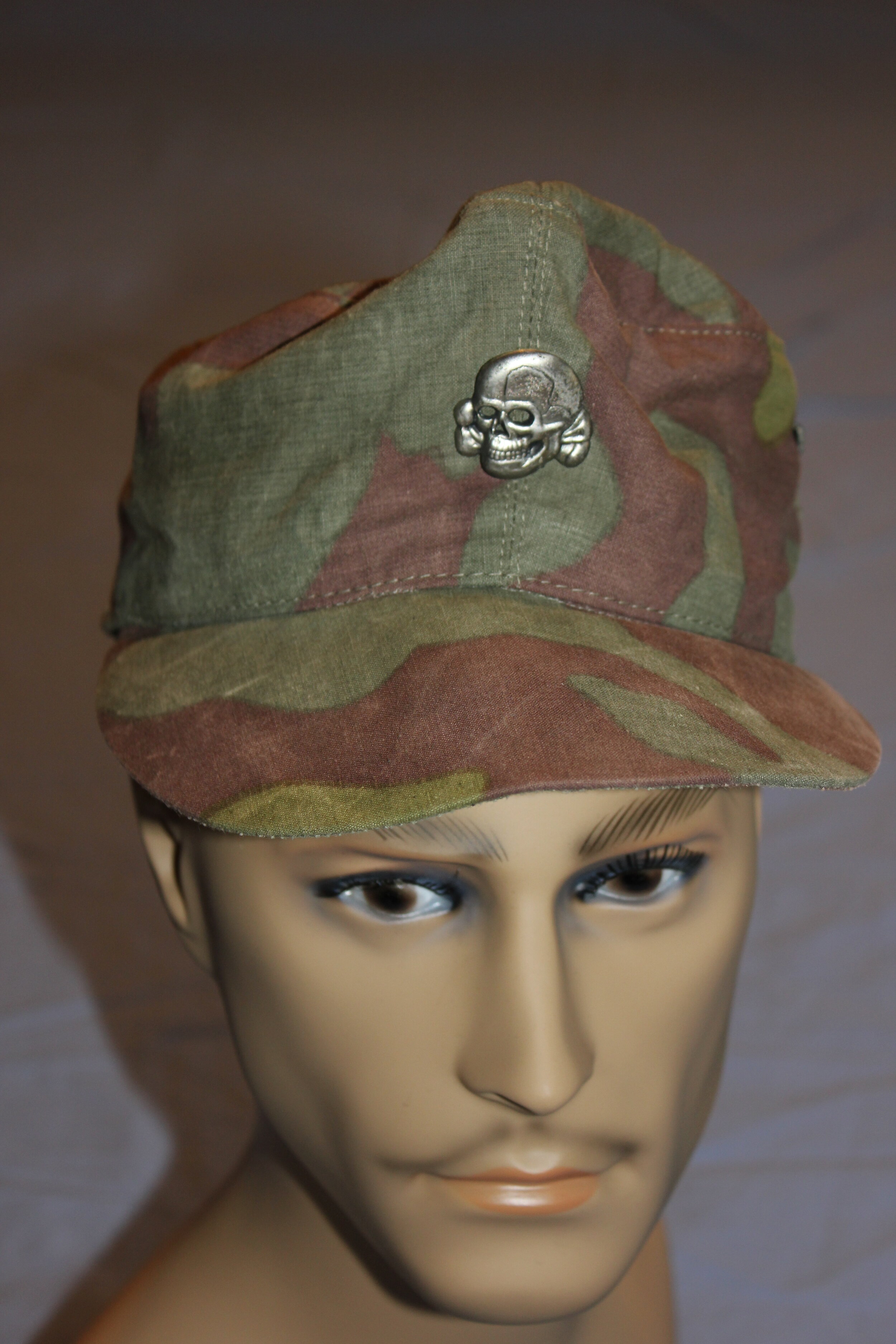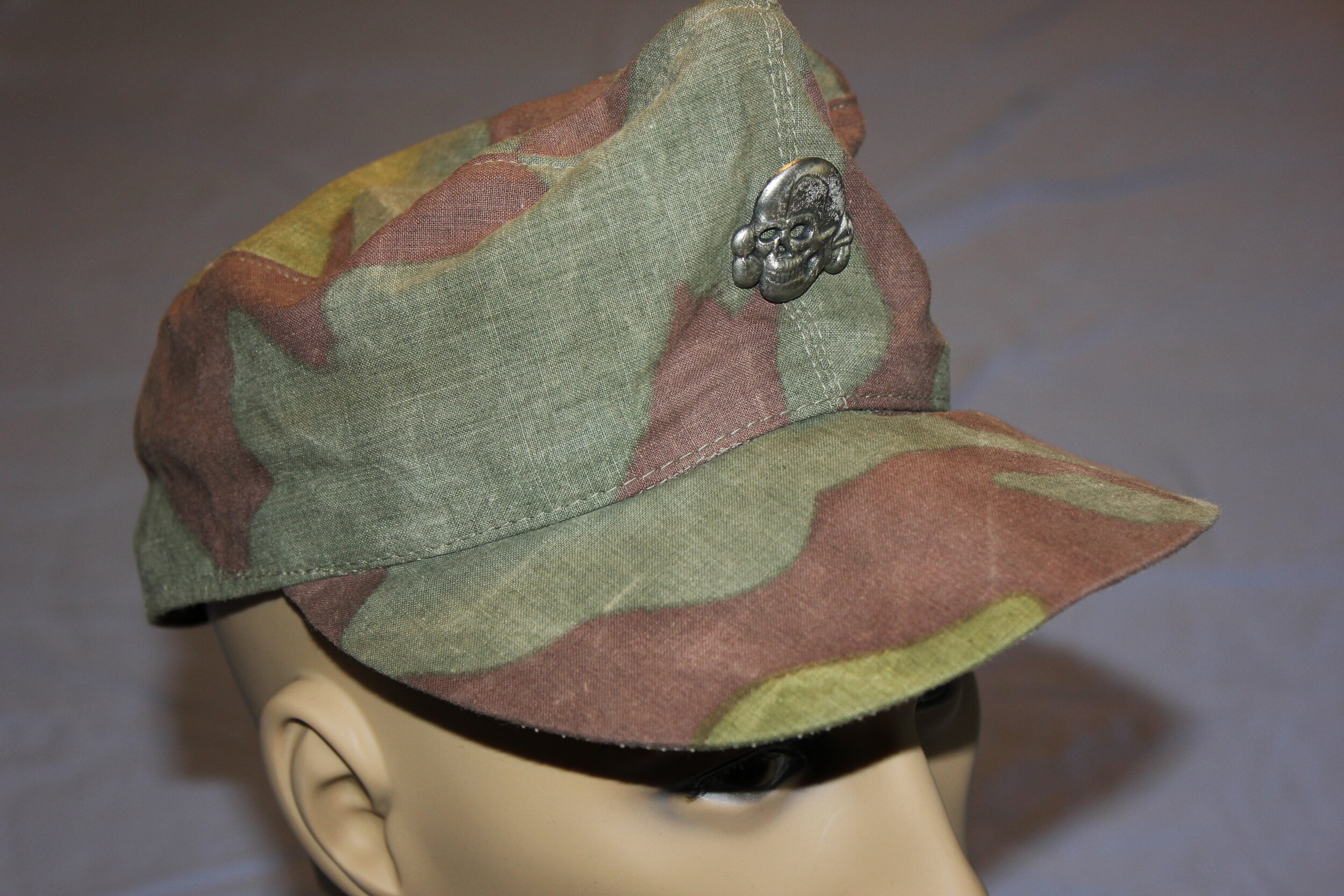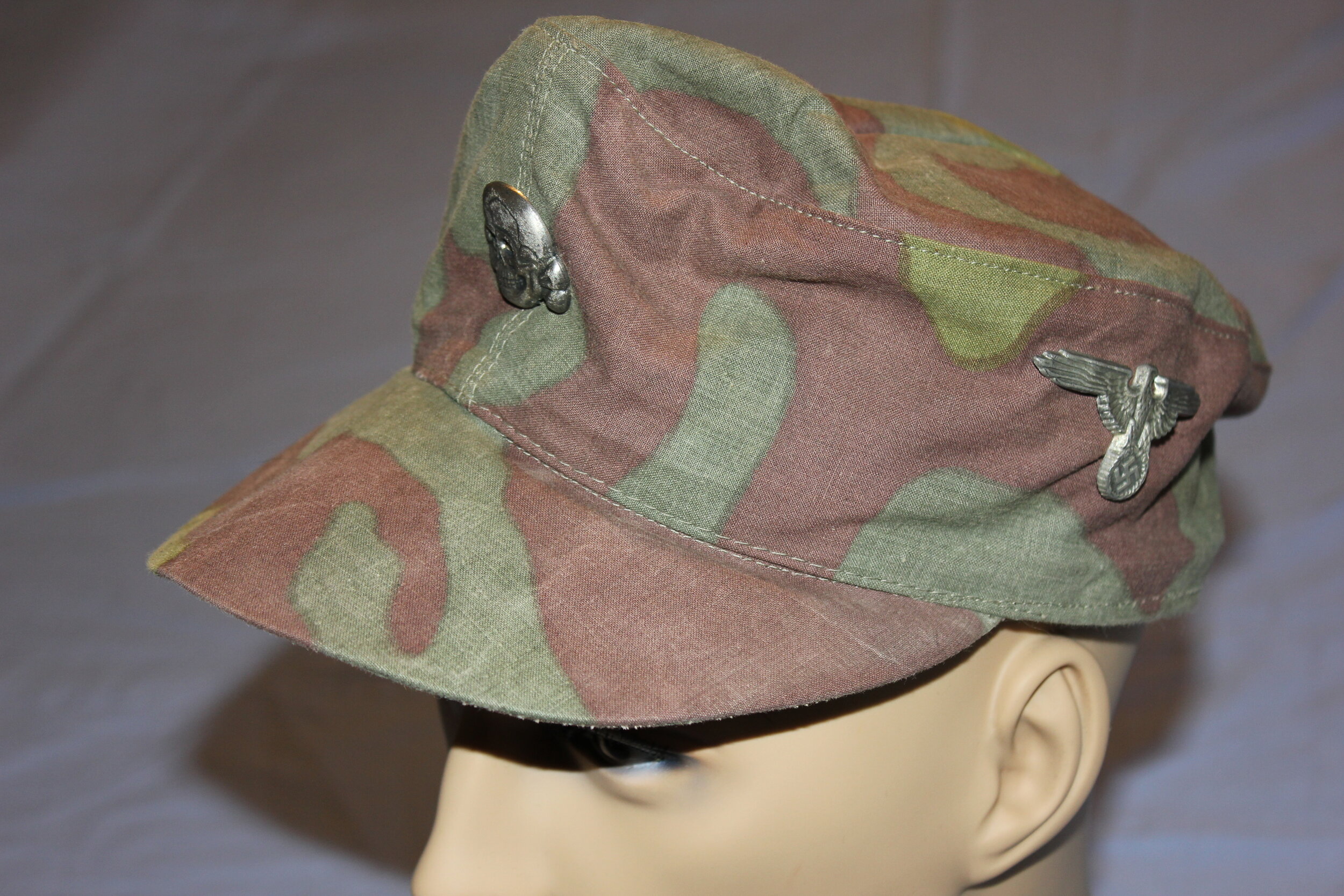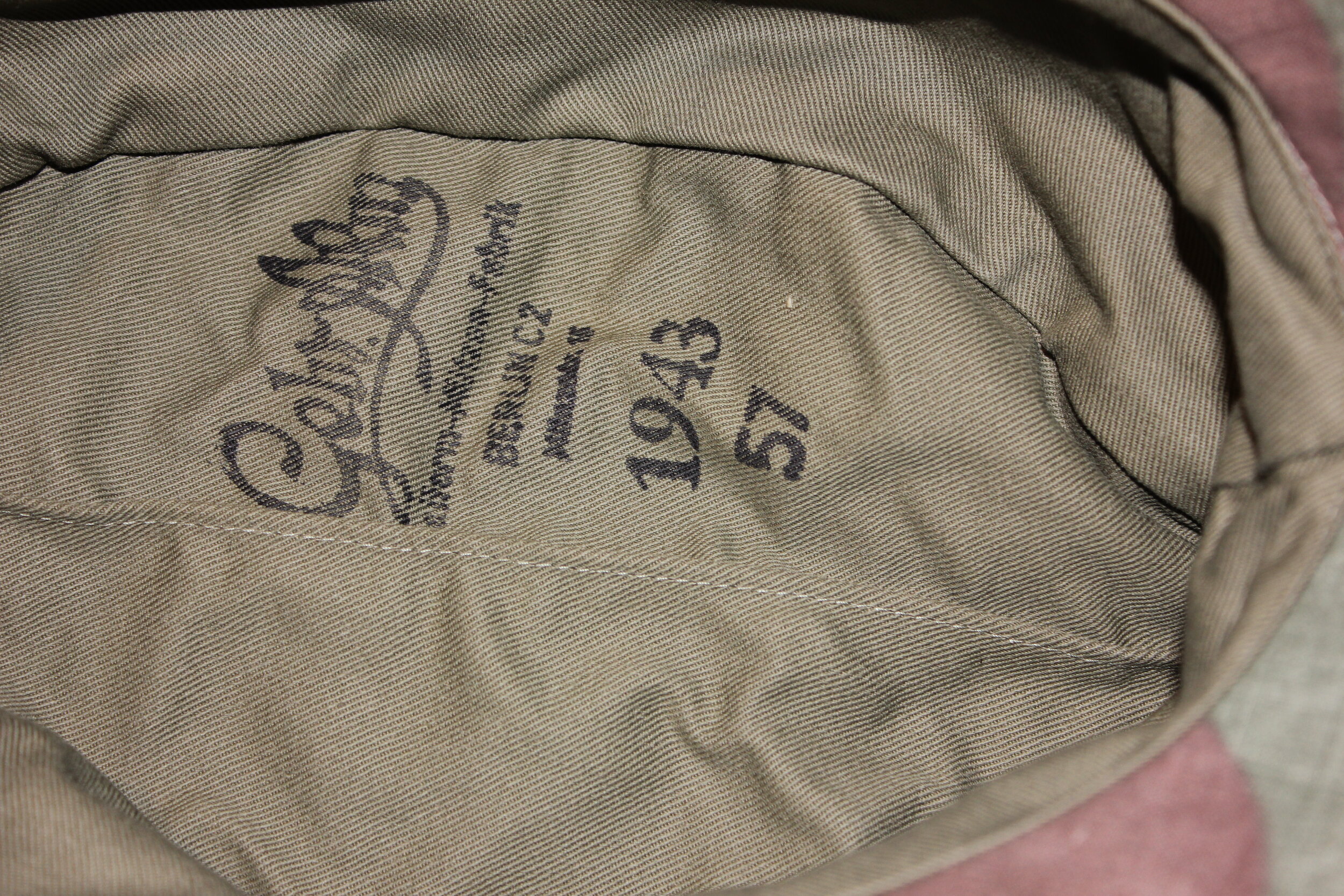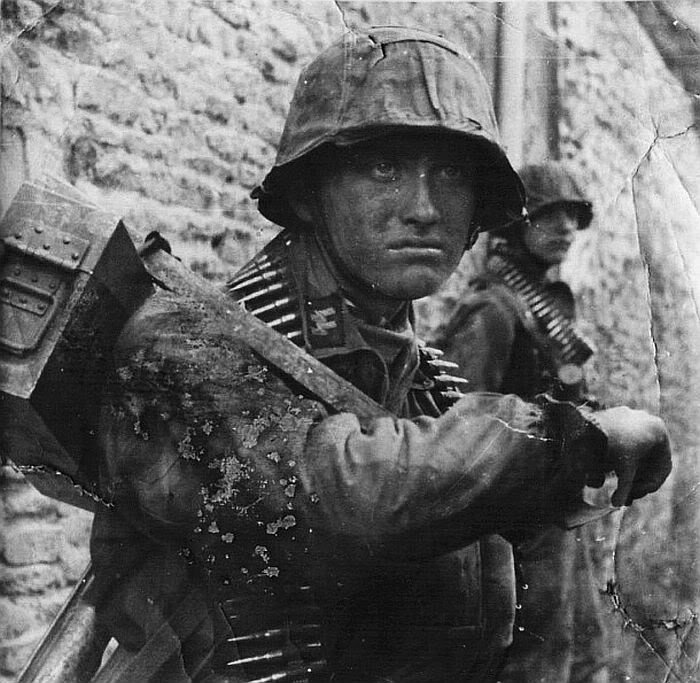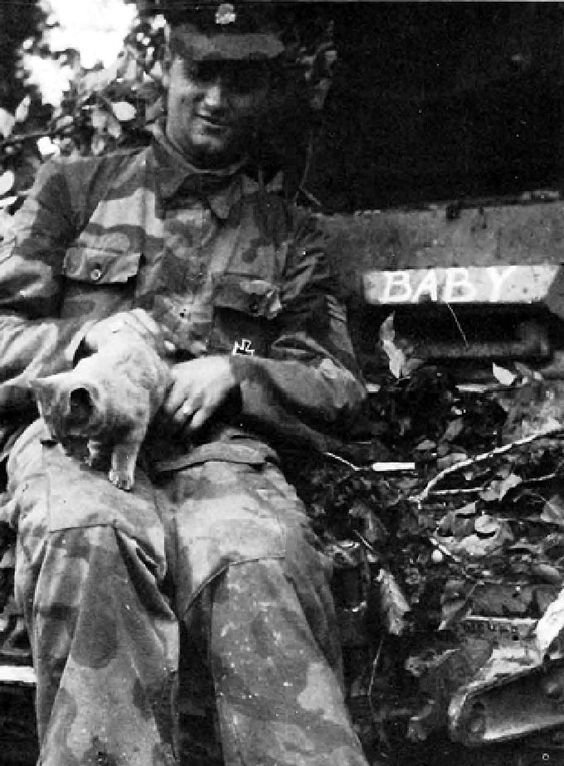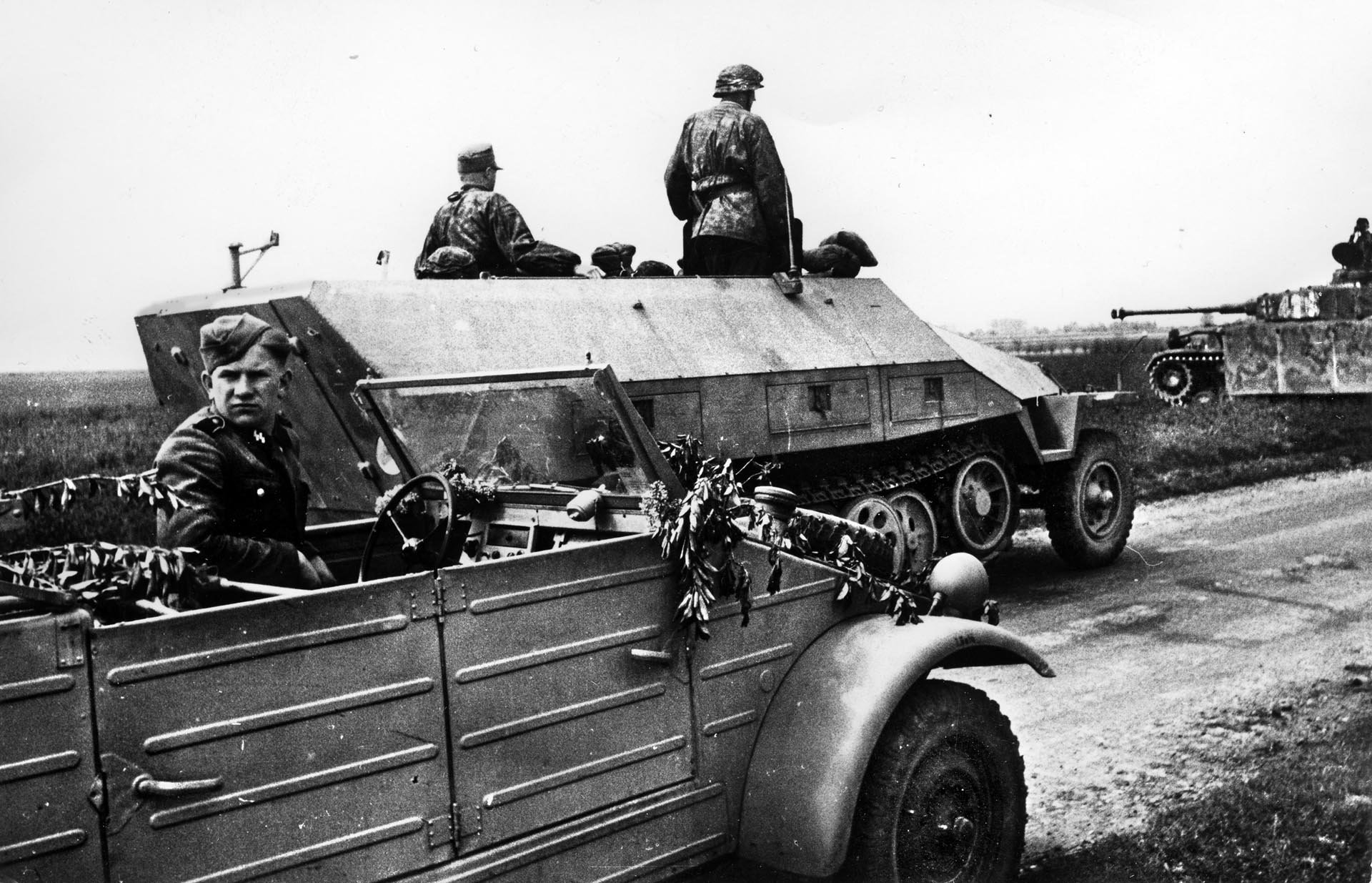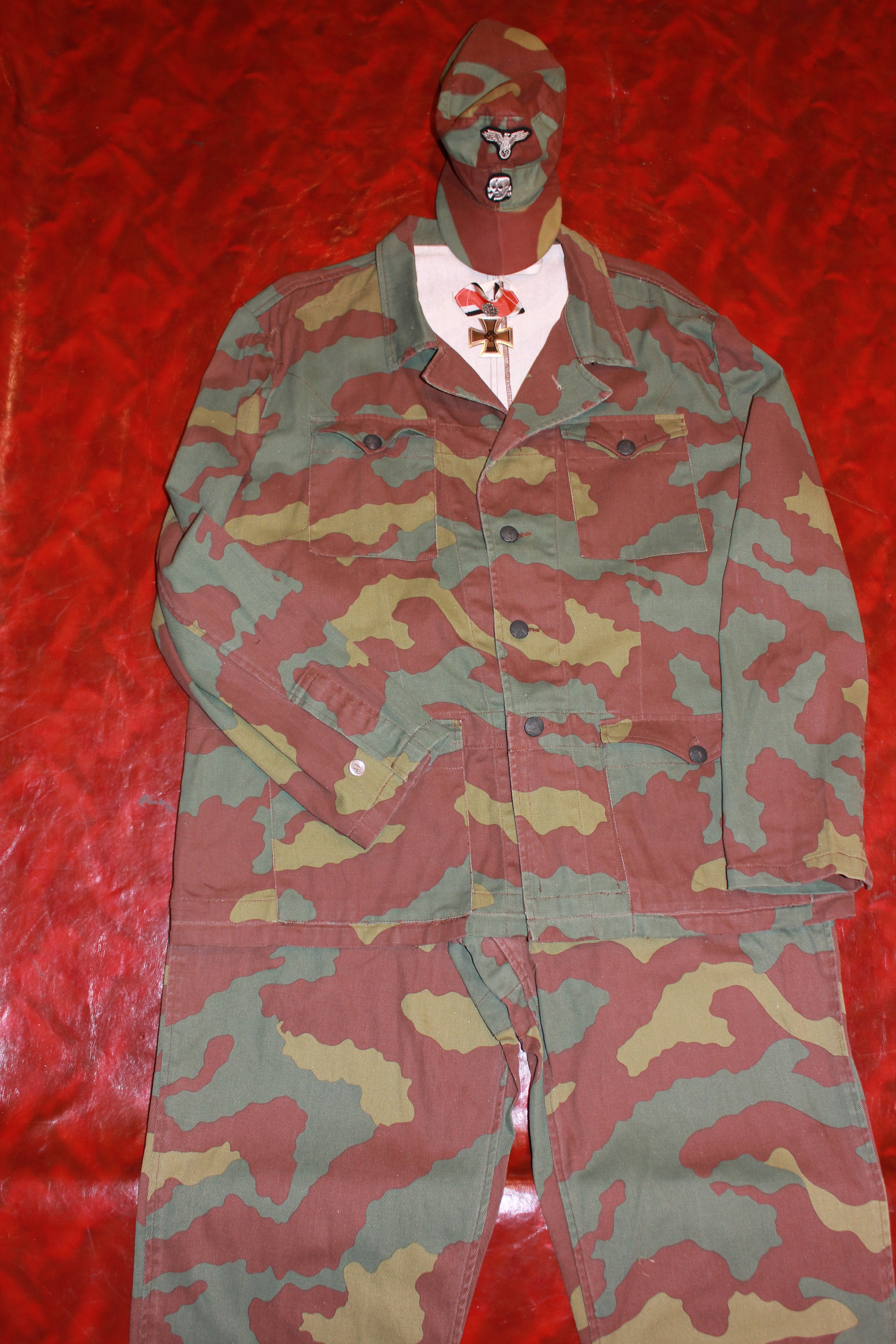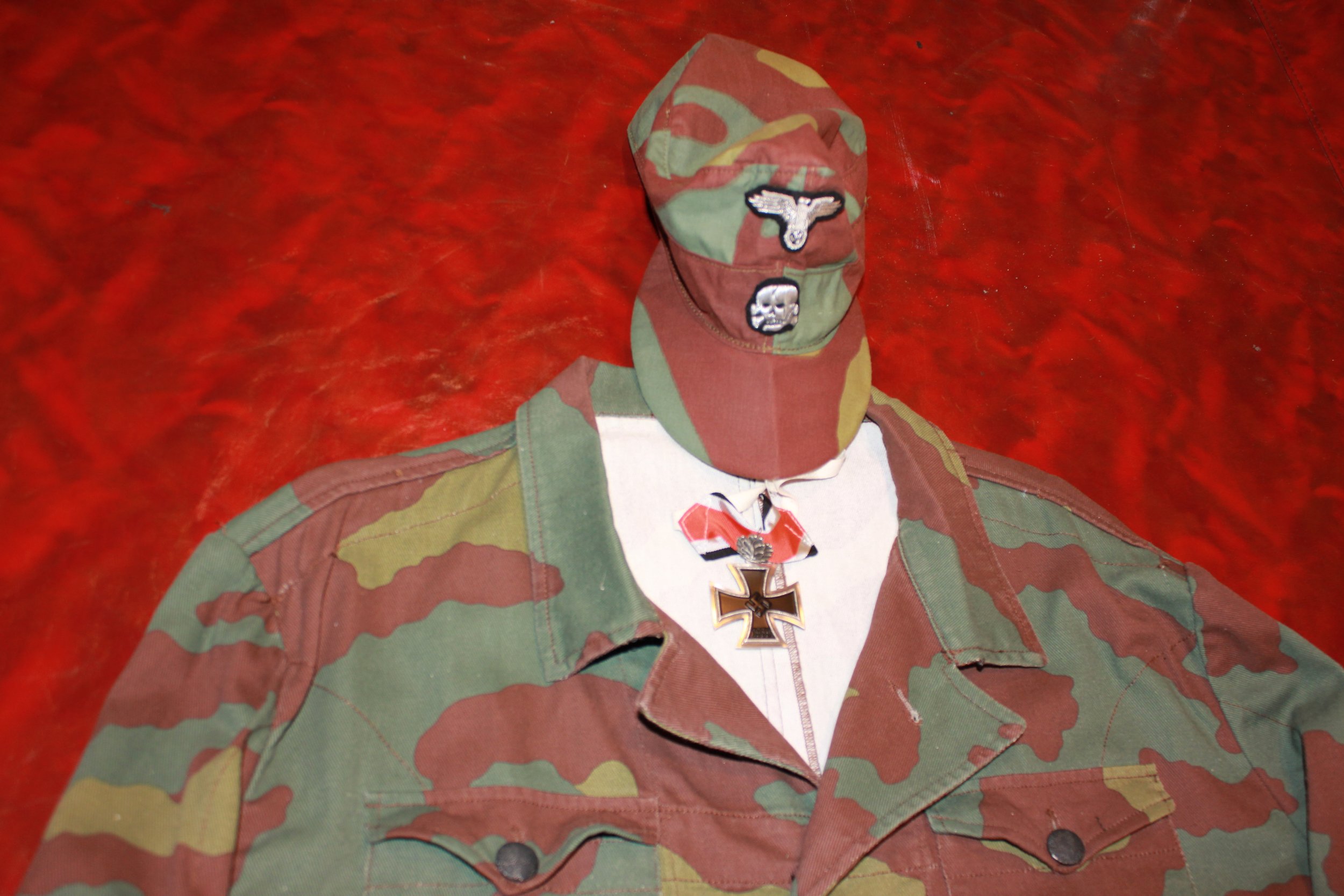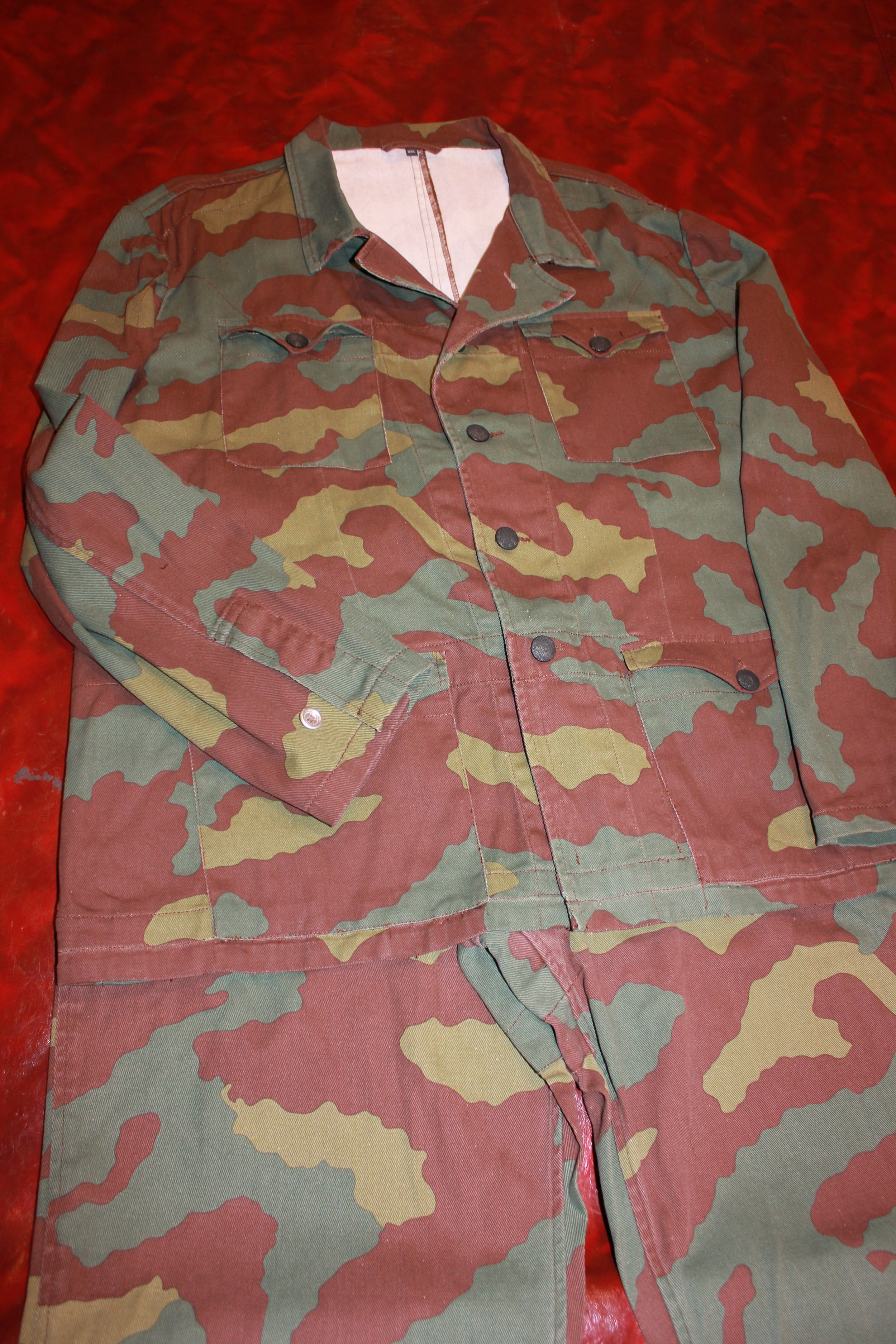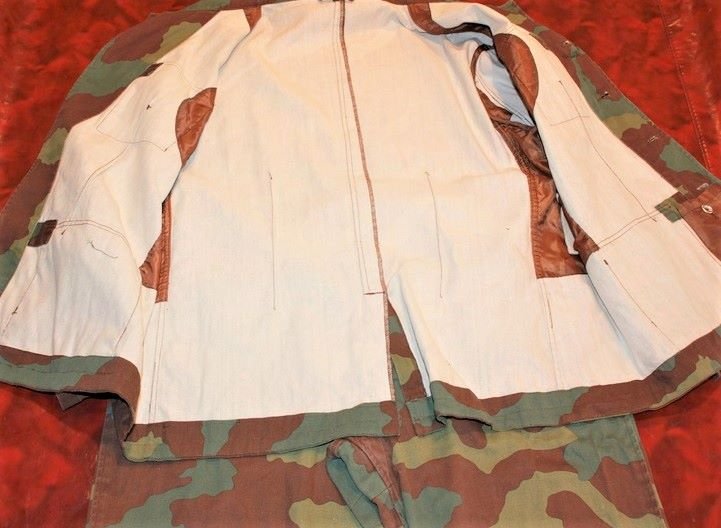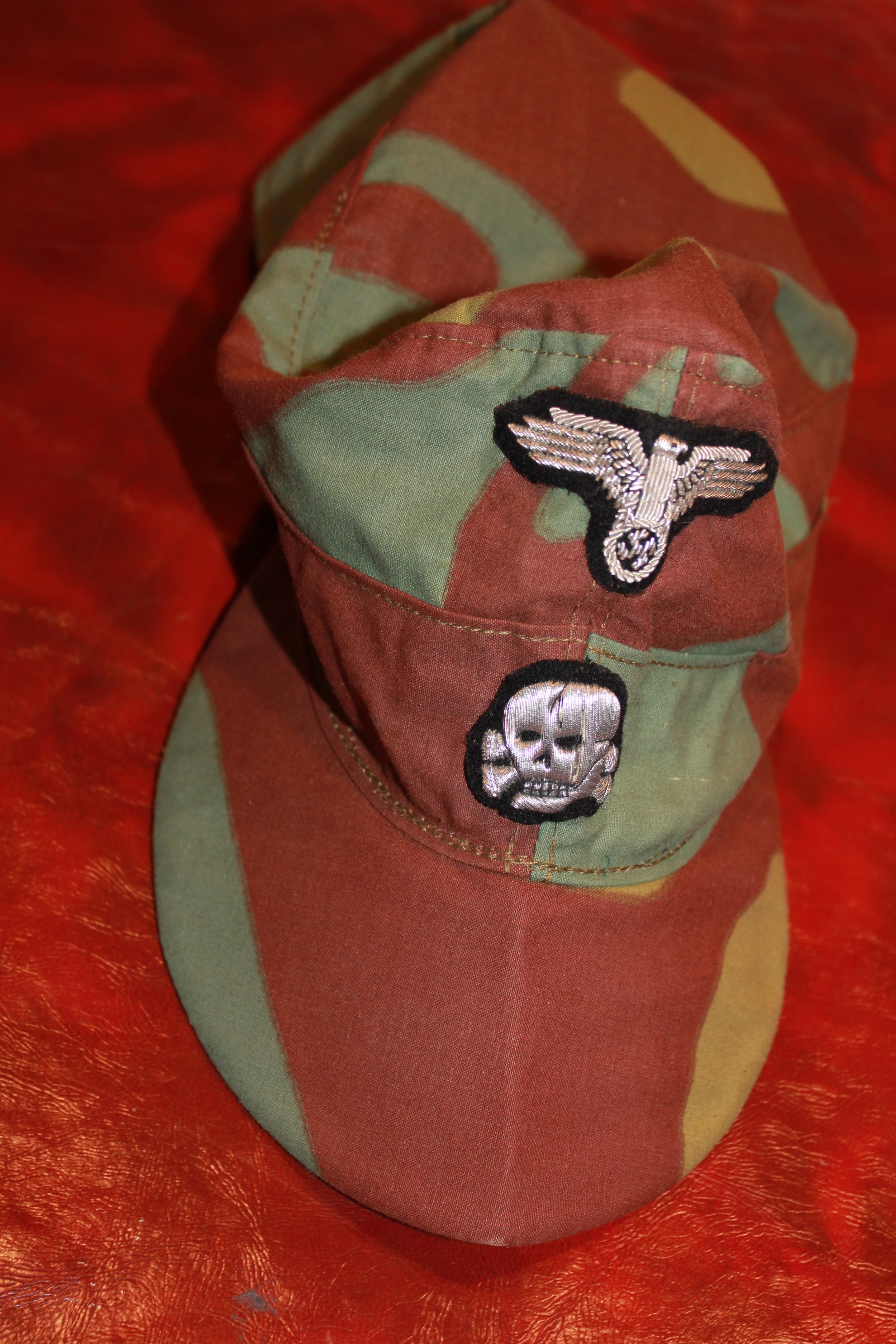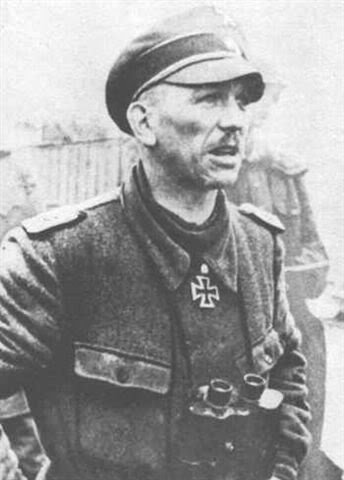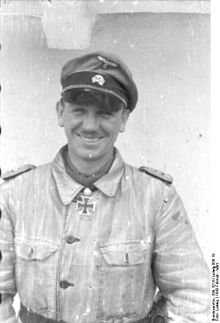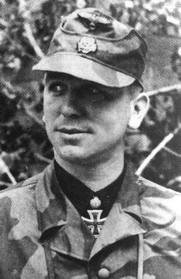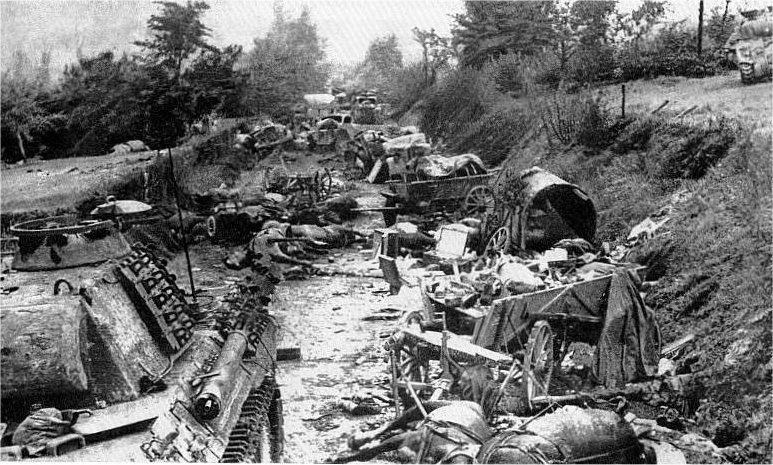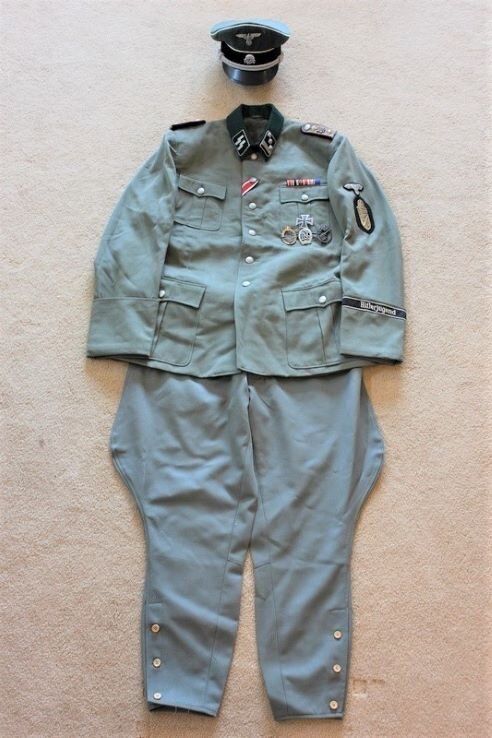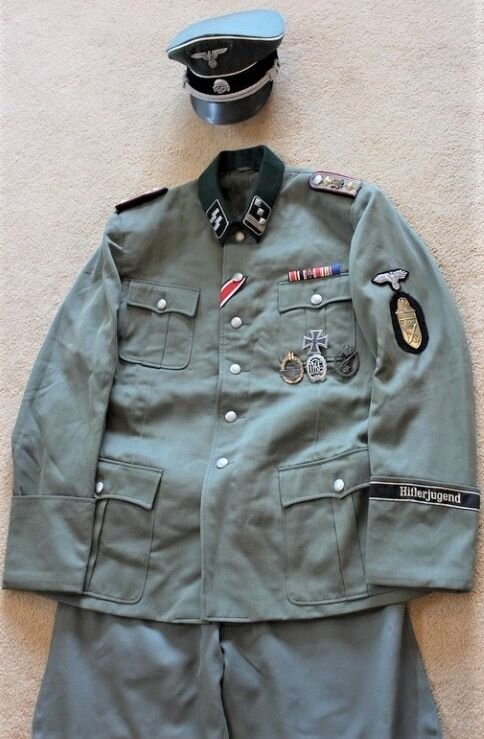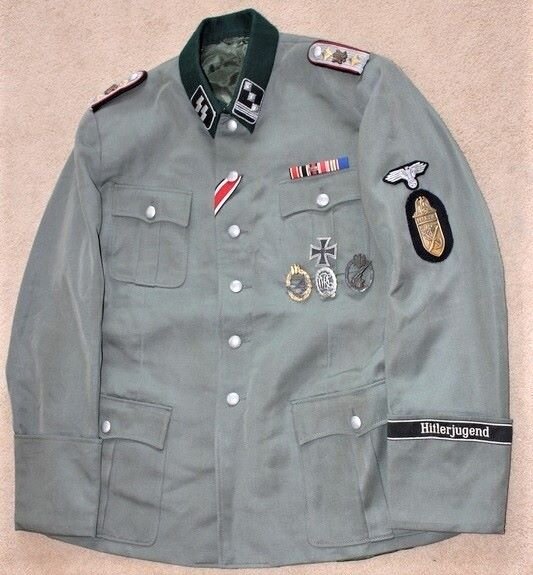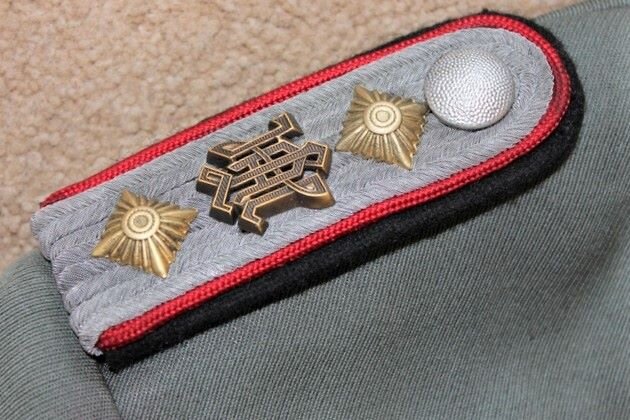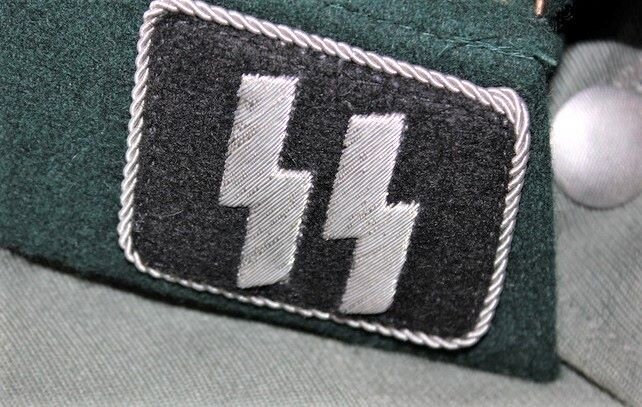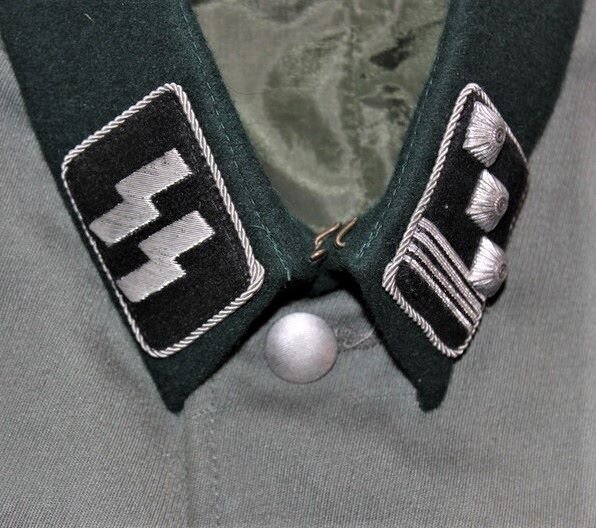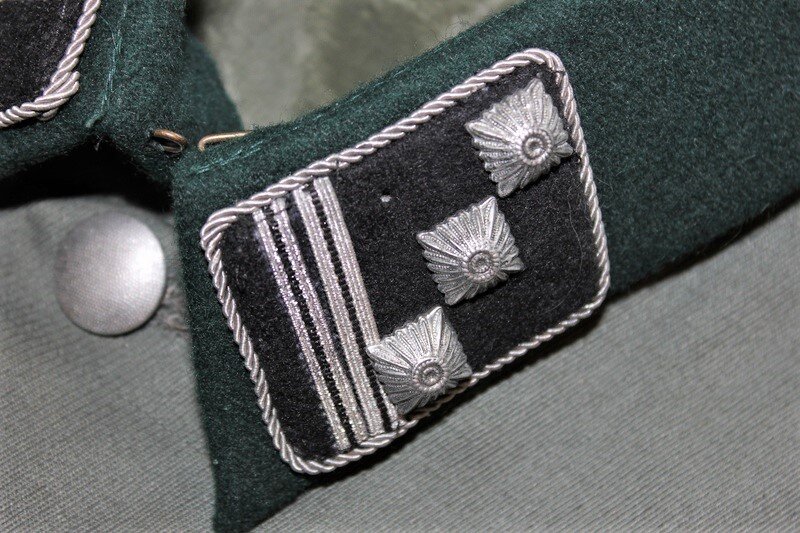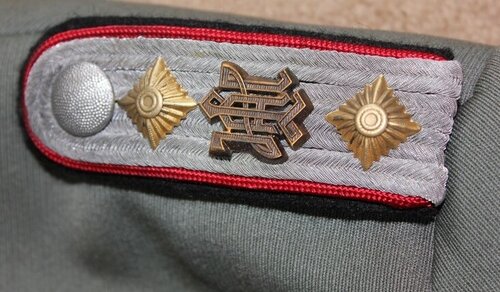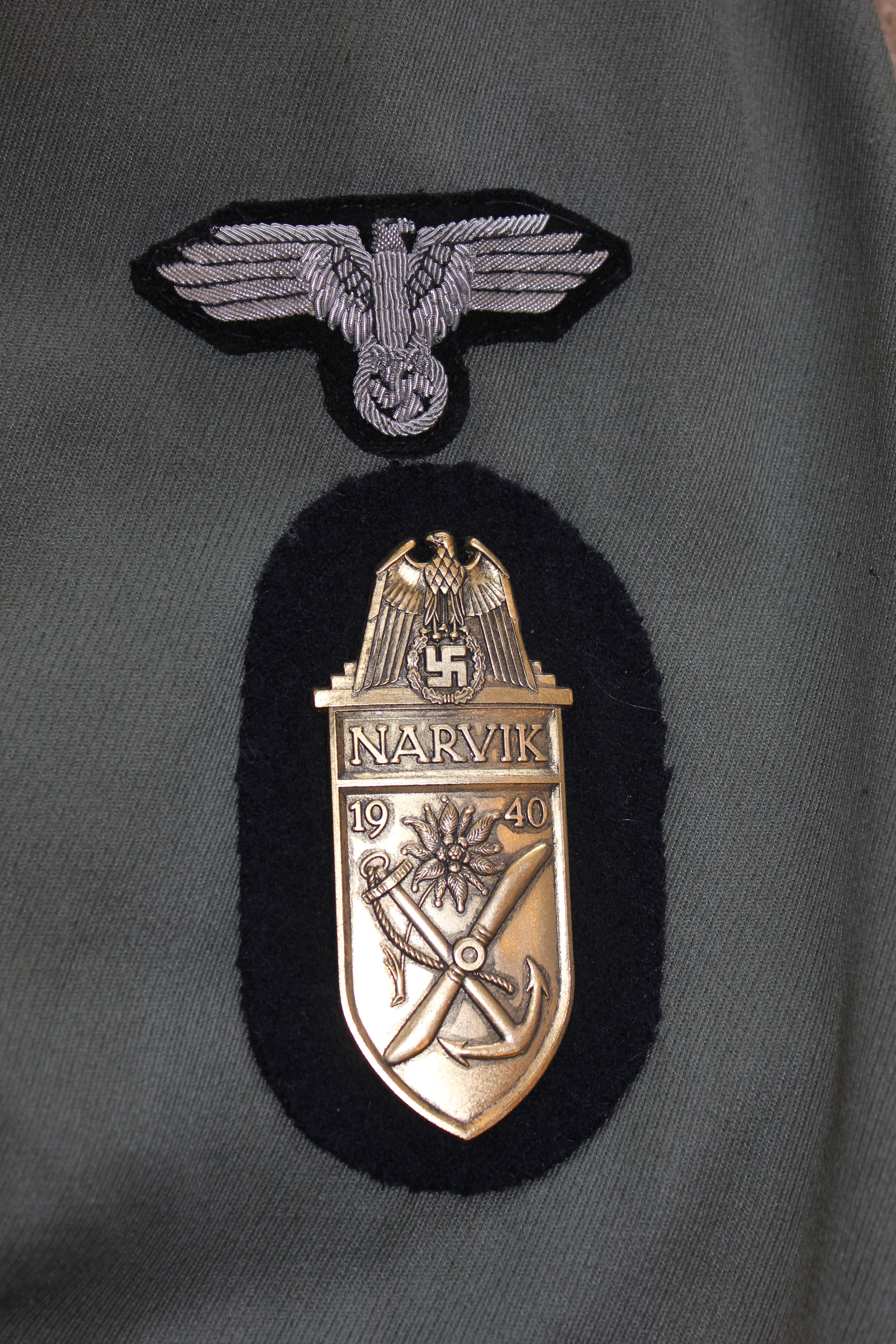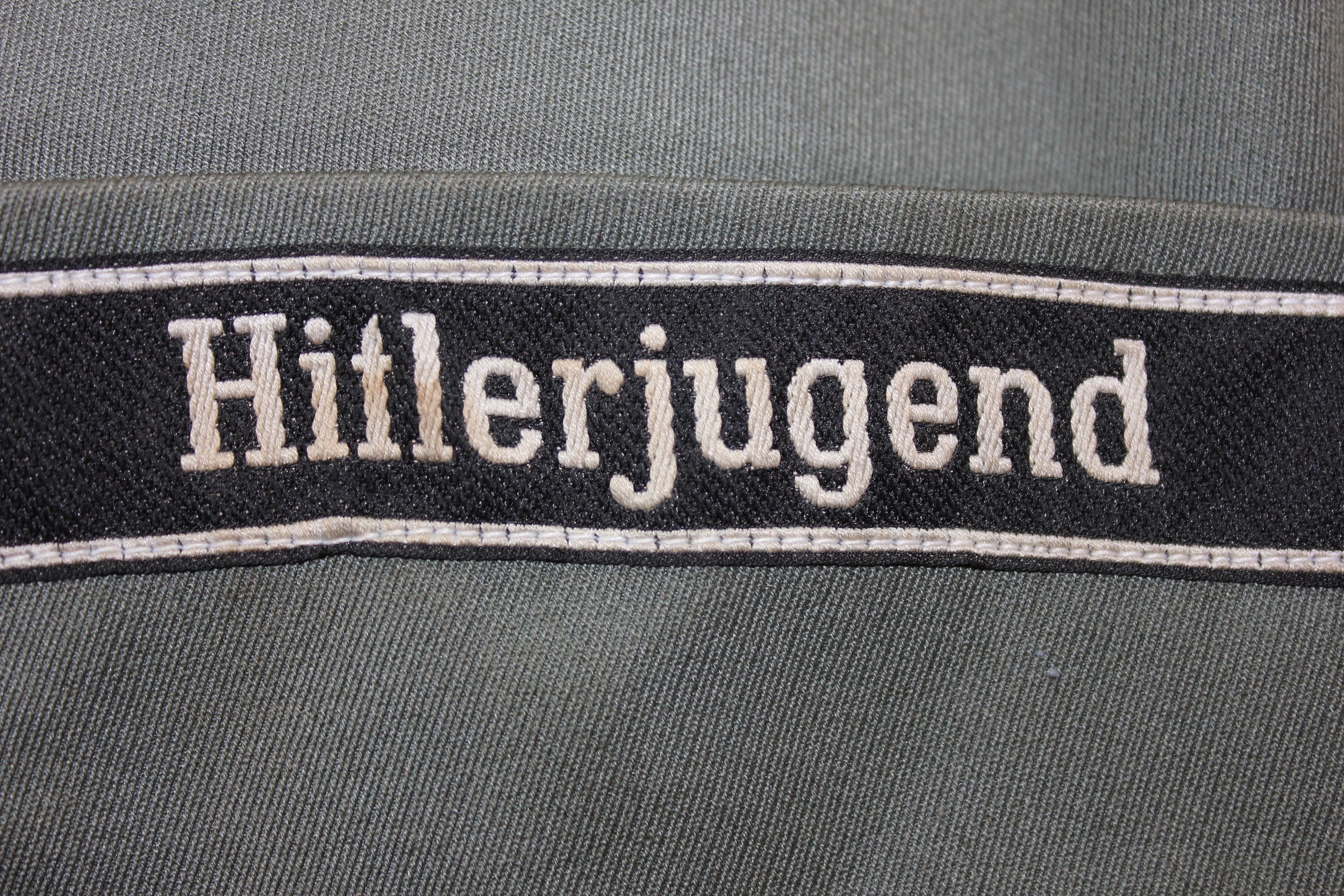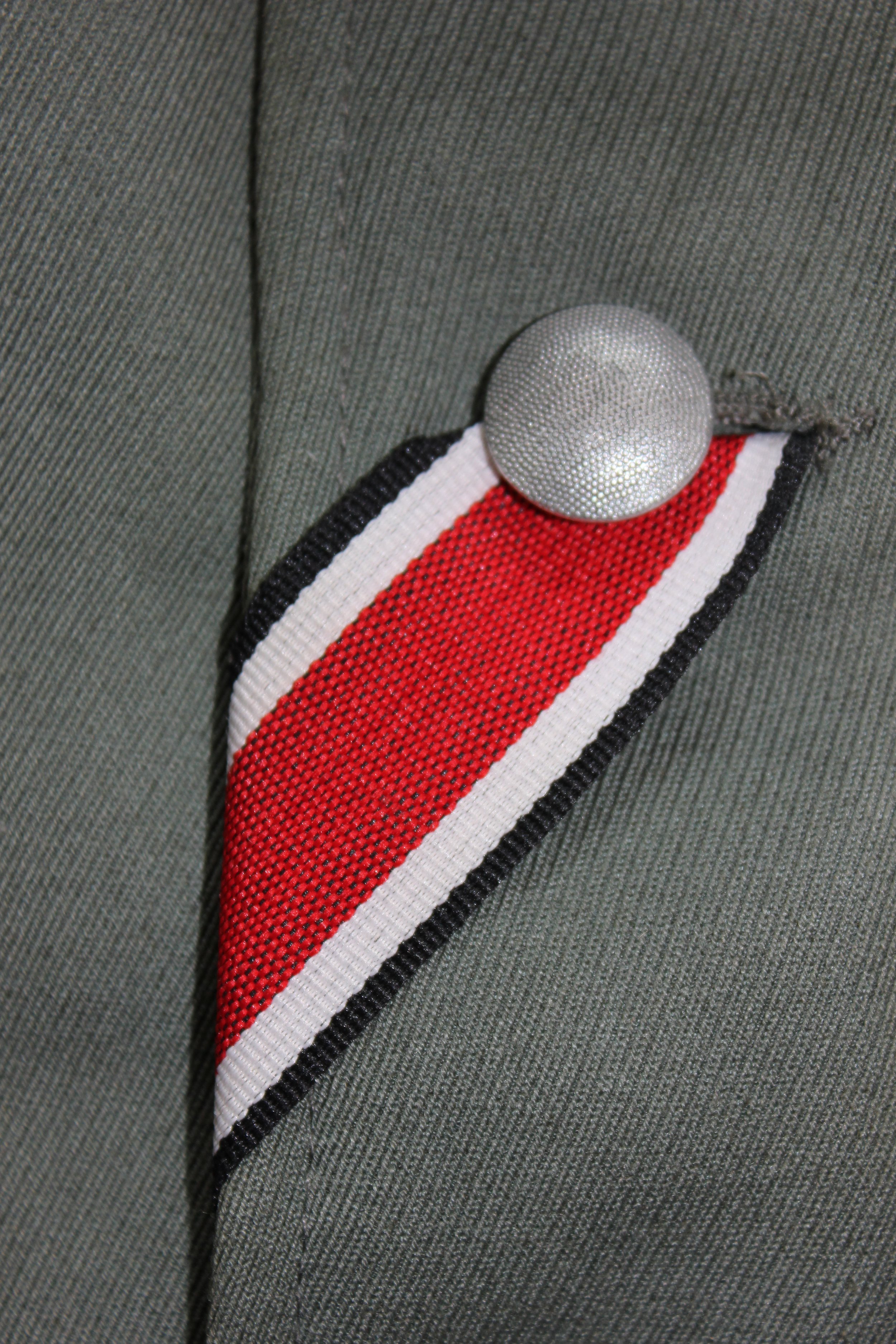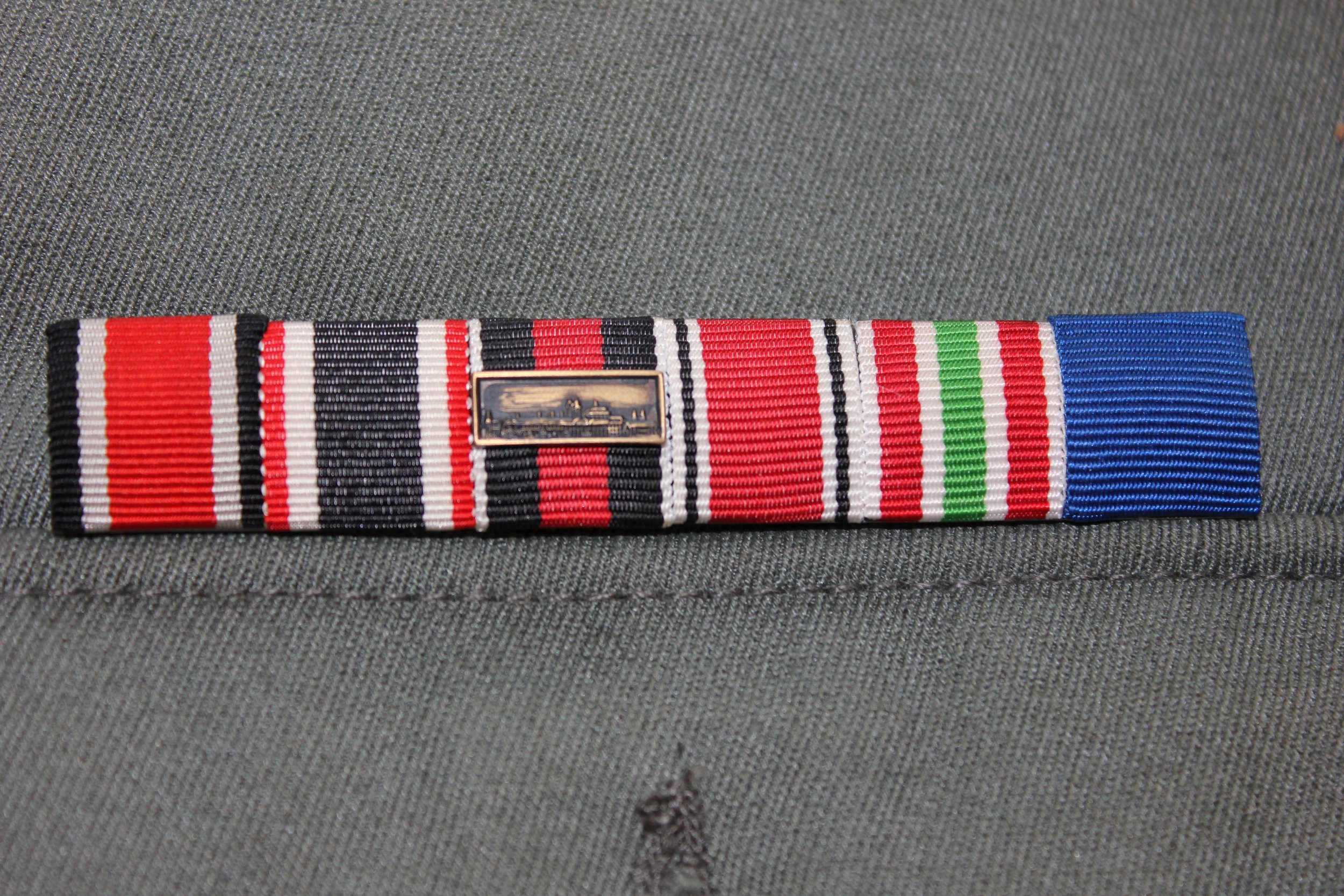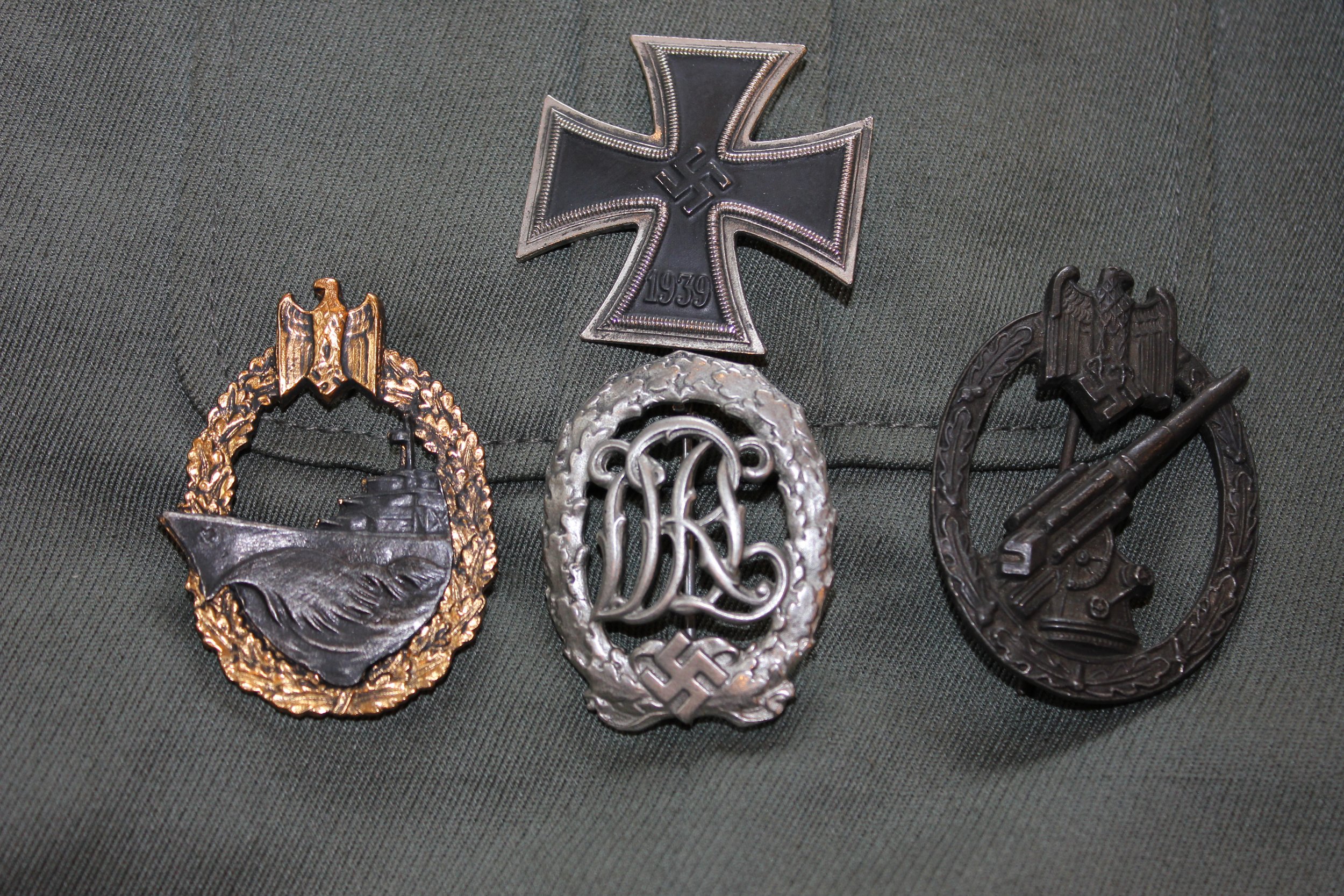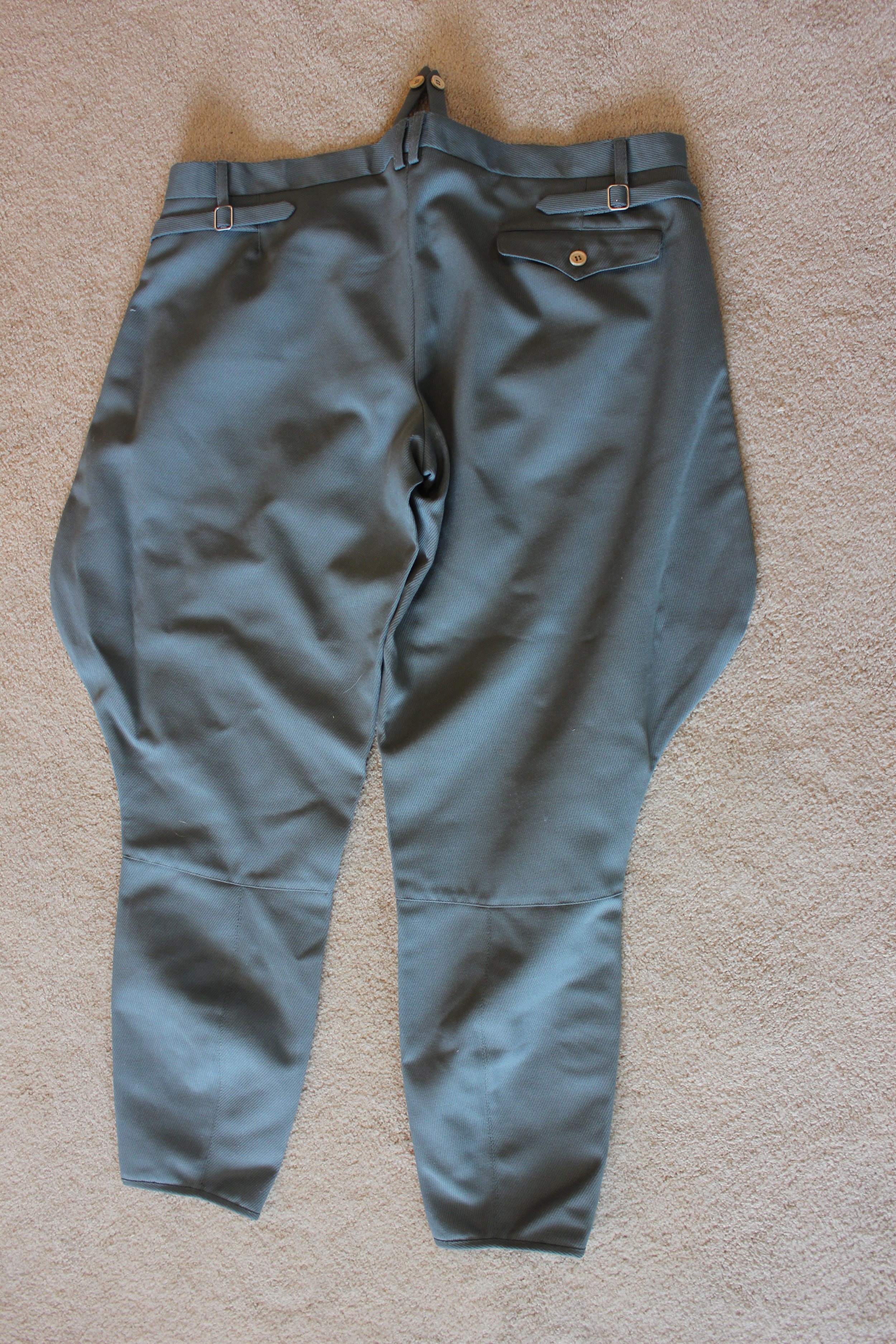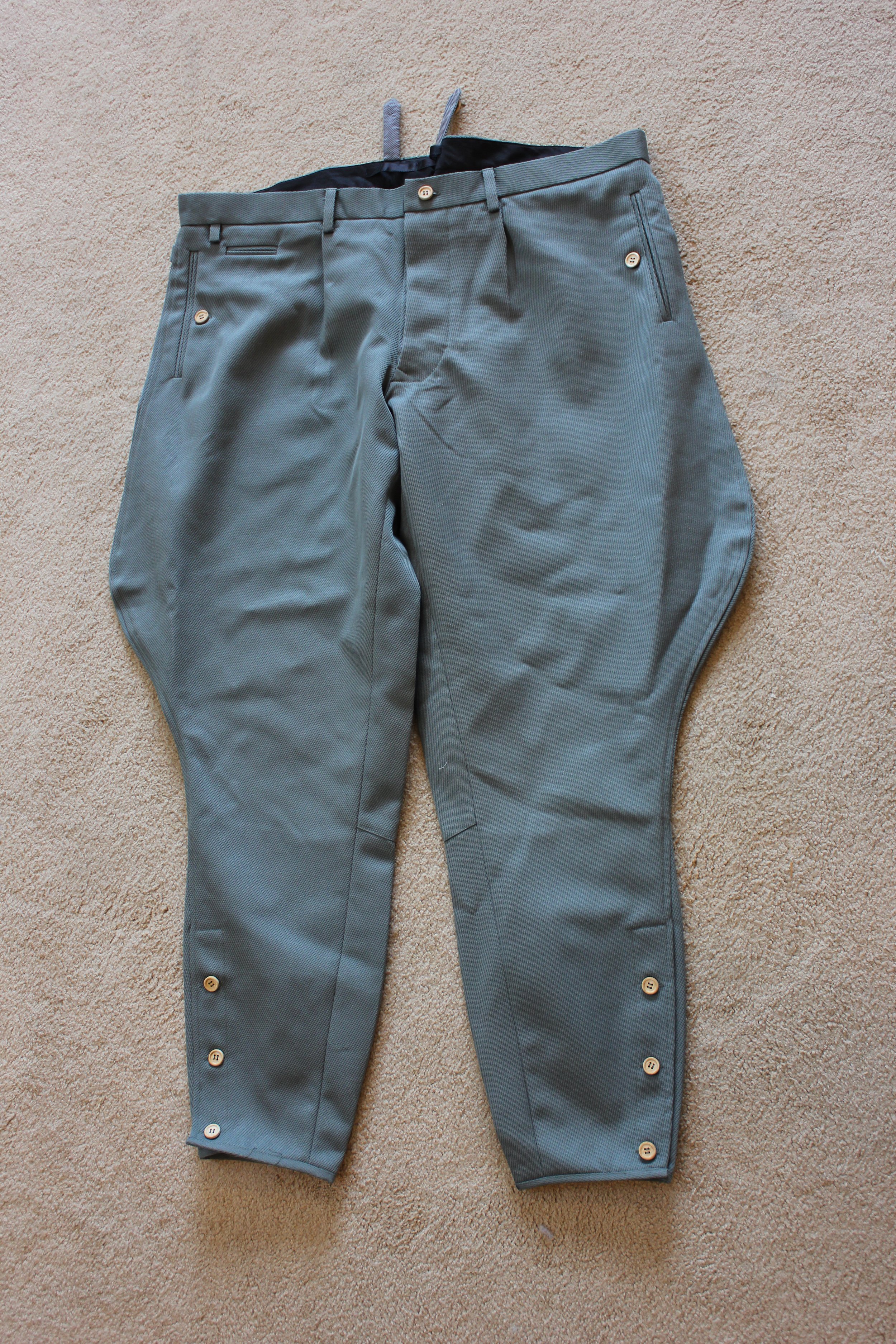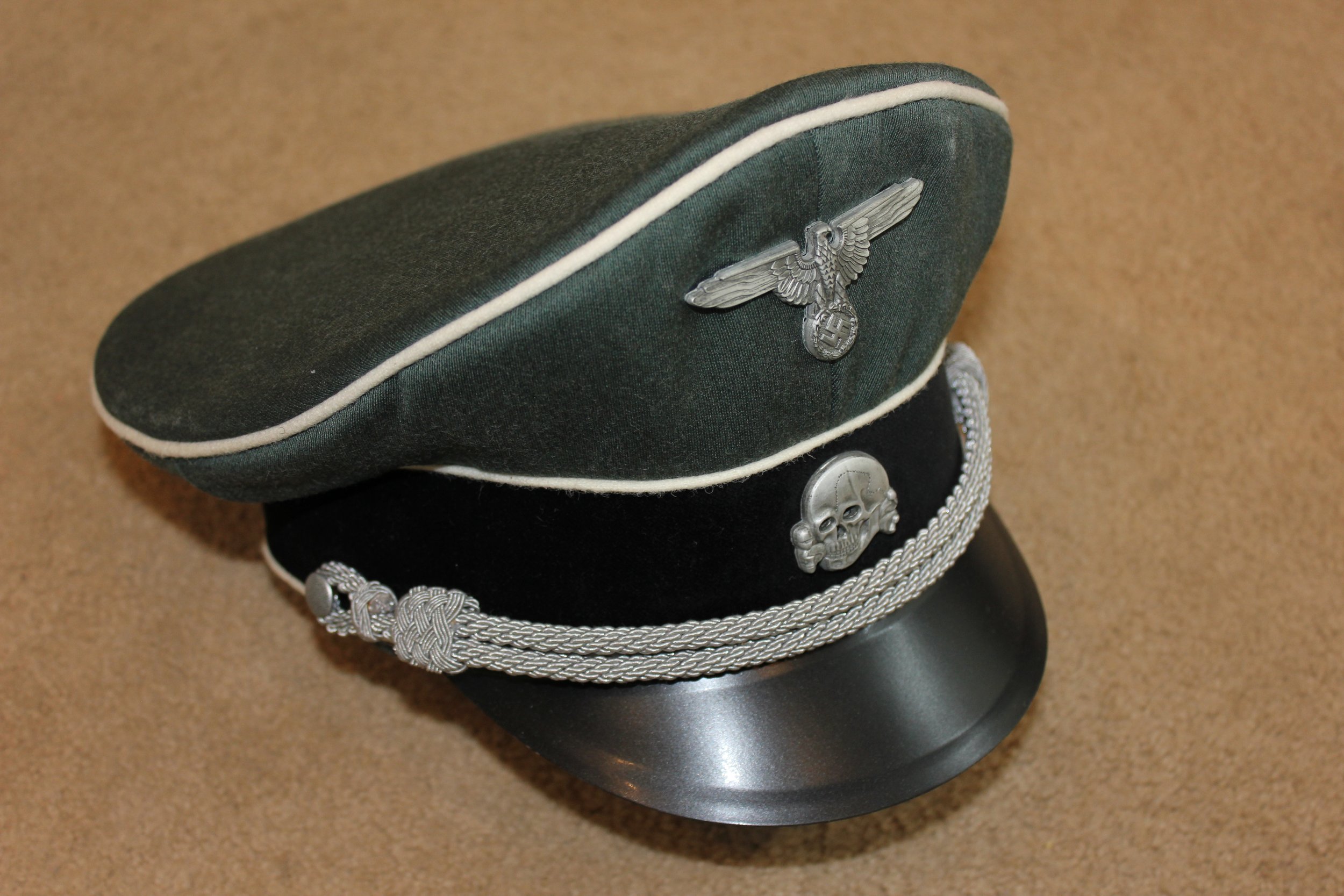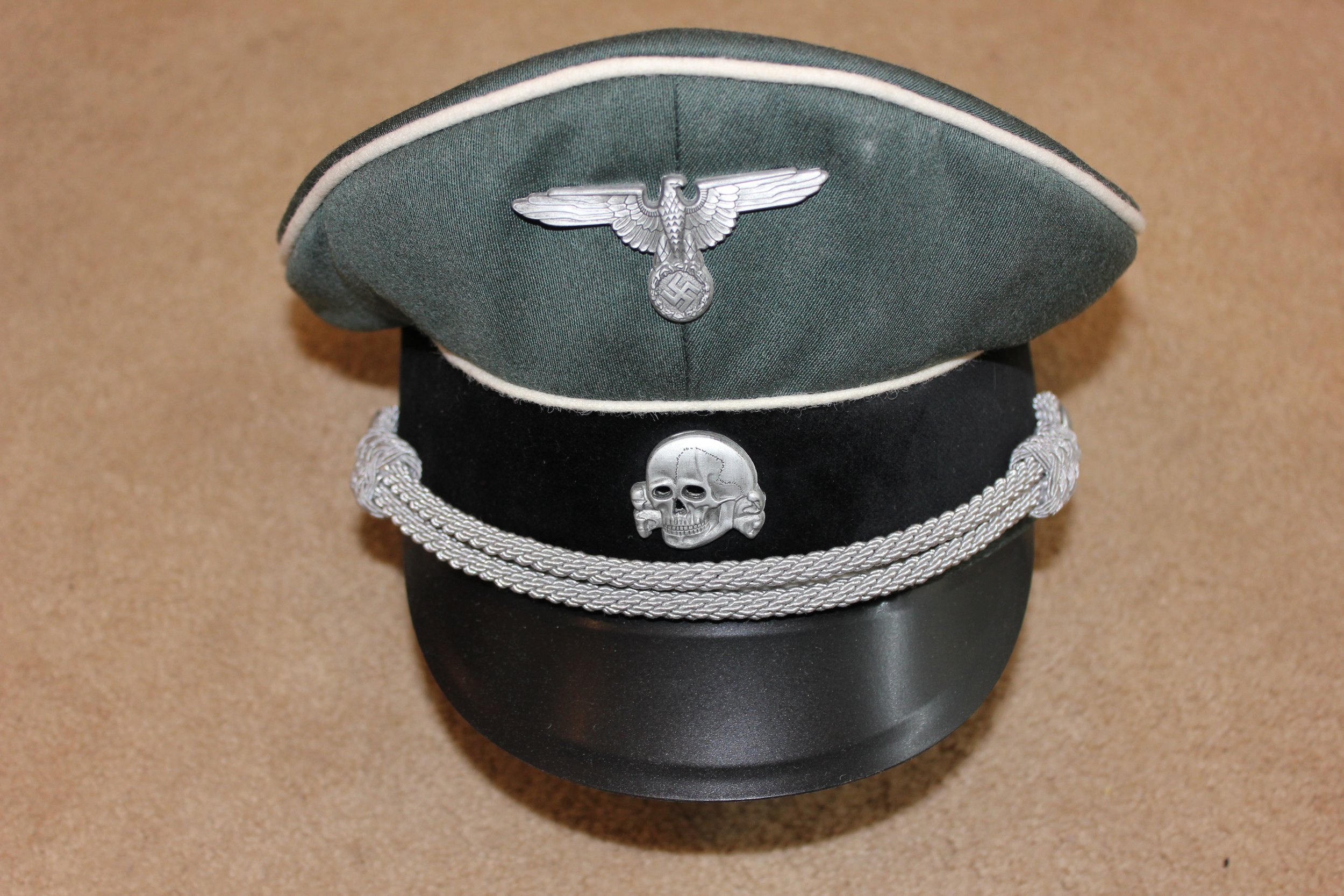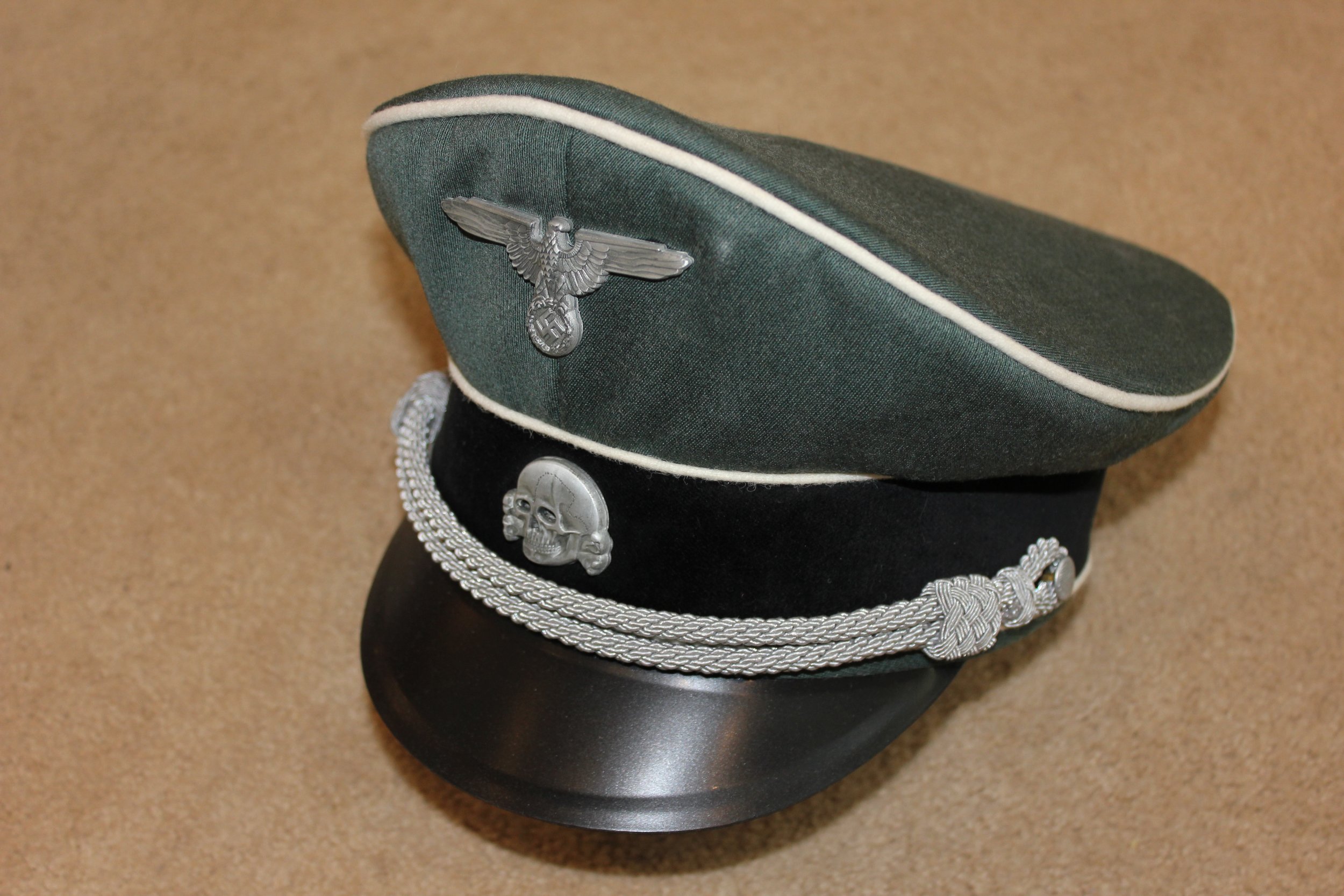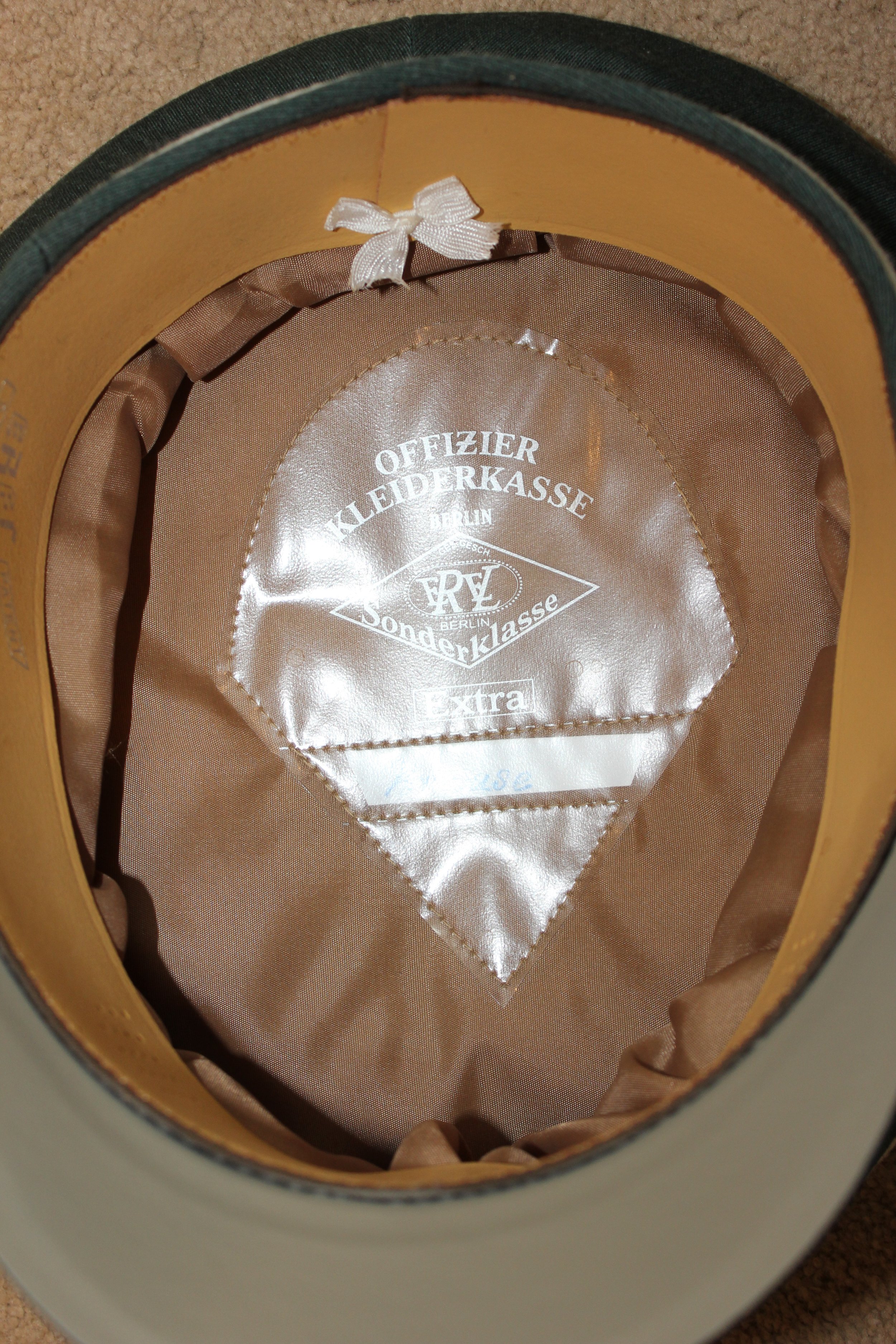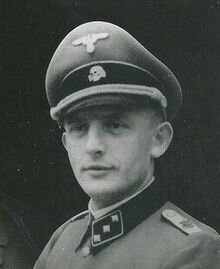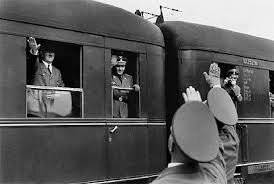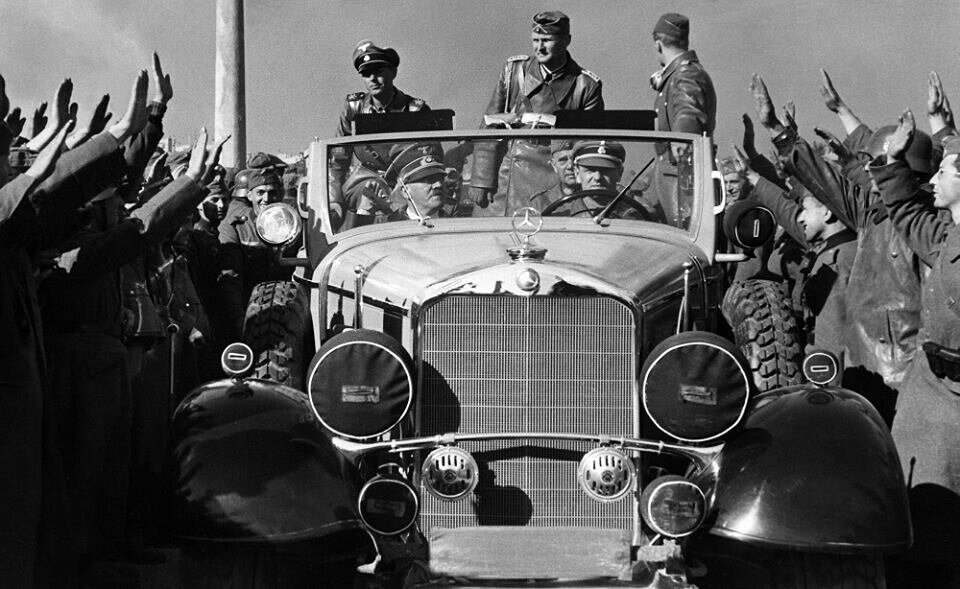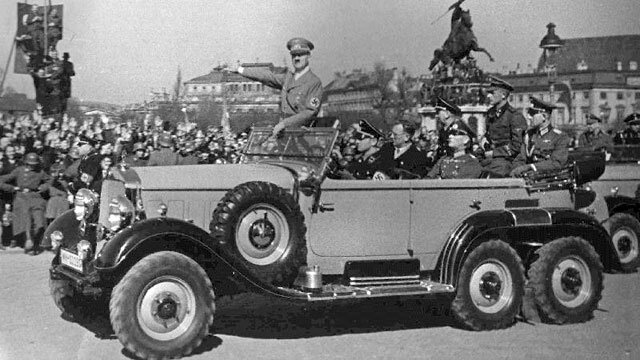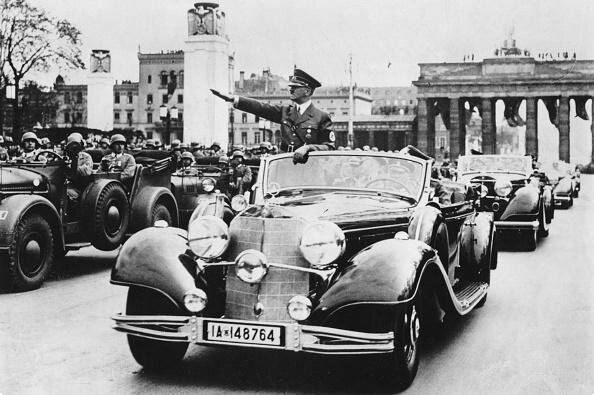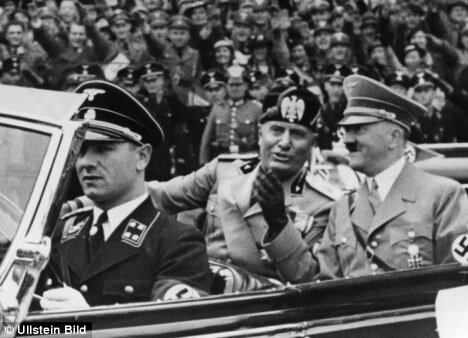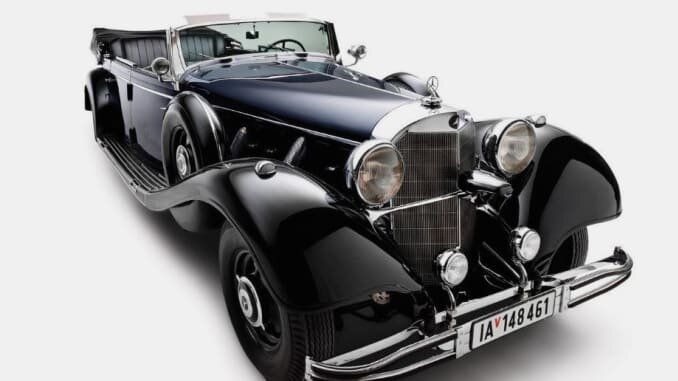“Hitlerjungen” 12th SS-Division:
SS-untersturmführer, 12 SS. Hitlerjugend, Feldgrau Jacket (1st part of a set):
SS-untersturmführer, Hitlerjungen Division. Over Coat (Part #2 of the set):
12. SS-Panzer Division, NCO, 44-Dot / Pea-Camouflaged Wrap & Trousers:
Fighting in Normandy, the Ardennes, and Hungary, this NCO lasted until the end of the war. An old timer, he has the Infantry Assault badge showing that he was a grenadier before volunteering for tank training, most likely with the 1st SS Panzer Division.
He has fought in over 25 tank engagements, winning the Panzer Assault badge in silver with number 25. Wounded several times, he has been awarded the Black Wound Badge. He has been on the front since the invasion of Russia, which is shown by the Ost Front ribbon in the buttonhole just under the Iron Cross 2nd Class.
He was also awarded the Iron Cross 1st Class, possibly for the leadership of the young soldiers in his command in Normandy. The uniform is the late pattern SS camouflage, normally called 44 Dot by collectors.
His rank is shown by both collar-tab insignia and the shoulder boards. The rose color is the branch color of all armored units. He has used an officer-quality BEVO eagle and collar insignia to dress up his jacket, fitting his senior NCO status. The divisional cuff title is the standard issue BEVO awarded after the division has fought in Normandy.
This uniform is not unlike the” Bobby Woll” Tank Commander Uniform, the Hitlerjugend was well supplied with camouflaged uniforms. Many were in the “Dot 33” or P-Pattern, the Green and brown “Oak Pattern”, and the so-called “Italian Pattern”, but other countries still used them. like Belgium. These camouflaged uniforms were often applied to “Famous personalities” of the Leibstandarte-SS and Hitlerjugend Divisions, often seen in propaganda photographs. These patterns are not limited to the units in France, but all the SS started with smocks as issued to them, often later modified, that are seen in wartime photos, and rarely did an in any unit all match, there is a large variety of patterns too, making it hard to match, more often than not, it was grabbed soon as they showed up, and as their trouser’s, or jackets wore ou, something different grabbed, even with the standardized feldgrau uniforms, were by 1943, actually a mix of patterns worn on one individual.
12th SS Division, NCO / ‘Italian-Camouflage Coveralls:
I don’t have a story here for this particular set of coveralls, but they were seen in use in the Normandy Battles, and thereafter, the unit and battle were well covered in many books and articles; this was a practical over-suit that was often worn by itself.
Ritterkreuzträger SS-Standartenführer, Kurt Meyer, 12. SS-Division “Hitlerjüngend”:
In the Summer of 1943, Hitler declared the formation of the 2. SS-Division “Hitlerjüngend” was filled with members of the “Hitler Youth”, all 17-year-olds. The division commanding officers were to come from the 1st SS-Panzer-Division “LSSAH”, which was commanded by SS-Brigadeführer Fritz Witt.
Meyer was selected to lead the young Grenadiers of SS-Panzergrenadier Regiment 25, and he was promoted to SS-Standartenführer on 21 June 1943. Kurt Meyer was present when they were training at Beverloo in Belgium, and in early 1944, the Hitlerjüngend was moved to Hasselt in anticipation of the Allied Invasion.
On June 6, 1944, the Allies launched the amphibious invasion of France. after much confusion, the Hitlerjüngend advanced towards Sword Beach until they were halted by fierce Naval gunfire and Aerial bombardment, as well as anti-tank fire; they were ready for combat by 2200 on the 7th of June. Setting up his command post in the Ardenne Abby, whose tall towers gave an excellent view across the rolling hills of Normandy.
The following days would see heavy, and furious fighting there, over the next two weeks the regiment would suffer badly, And the German youth bleed. They would fight hard in the battles at Carpiquet Aerodrome and back through the villages of Contest, Buron, and Authie.
On the 14th of June, SS-Brigadeführer Fritz Witt was killed when British Naval Gunfire destroyed his command post. Meyer, as the next highest-ranking officer, was promoted to divisional commander. At 33 years of age, he was the youngest of the German divisional commanders of the war.
Meyer managed to hold the line North of Caen despite several British and Canadian offensives. By July 4th, the division was reduced to a weakened battle group. Despite this, Meyer still clung to the Carpiquet Airfield while wave after wave of Allied troops and tanks tried to wrestle it from his grasp.
By 9 July, Meyer realized that reinforcement was not coming and that he had to withdraw his division or clearly it would be annihilated. On 10th June, despite orders by Hitler of “NO Retreat”, Meyer ordered the Hitlerjüngend to be pulled back Orne River, abandoning Caen to the Allies. In just over a month of fighting the Hitlerjüngend had been reduced from some 22,000 men to just under 5000 which had to be evacuated from the Falaise Pocket.
On the 27th of August, he became the 91st soldier to be awarded the Knights Cross of the Iron Cross with Oak-Leaves. Meyer with the remnants of his youth division joined in the retreat across the Seine River and into Belgium.
On 6 September 1944, in the town of Durnal near Namur in Belgium, wounded and trapped, he was captured by partisans and handed over to the American Forces. Because he was missing in action and presumed dead, he was retroactively promoted to Brigadeführer und Generalmajor der Waffen-SS effective September 1.
Near the Ardenne Abbey, Kut Meyer had changed into what is commonly called the “Normandy pattern SS-Camouflage”; his M43-style blouse has squared pocket flaps, pleated pockets, and what appear to be Zeltbahn buttons.
Karl Wilhelm Krause, 12th SS Division:
A student of cabinet and architecture, Karl Wilhelm Krause, joined the Reichsmarine, the Navy of the Weimar Republic, in 1931. In 1934, Krause was chosen for his performance and bearing by Navy senior staff to participate in a process to provide Adolf Hitler with a personnel orderly and bodyguard. Personally selected by the Fuhrer, Krause was given the rank of “SS-Untersturmfuhrer”, maintaining a corresponding rank in the Kriegsmarine, and assigned to Hitler.
A part of the Fuhrerbegleitekommando, Krause was nearly always in Hitler’s presence. His nickname was “Schatten” or Shadow. He was always behind Hitler, or by his side at the Führer’s events, in vehicles, at his meals, etc. Hitler informed Krause that he was under his command and bound to his discretion at all times, and never to share what he saw or heard. In 1935, Hitler took on an additional valet, Heinrich Linge, and thus Krause trained Linge for the position.
On Christmas Eve of 1937, Krause and the Führer were on their knees, wrapping presents. In a friendly manner, Krause wrapped a bow on the Führer’s thumb. He laughed, then said to Krause, “Give me your Dinner Jacket”. Krause, confused, asked, “But Mein Fuhrer?”, “We’re going to spend Christmas Eve like real people”, replied Hitler. He took off his NSDAP uniform and put on Krause’s Dinner Jacket. They snuck past a couple of guards and called for a Taxi. Then Krause said Maybe I should sit up front, and you should sit in the back, “So the driver does not recognize you.” “Nonsense!” We’ll both sit in the back, was Hitler’s reply. The driver never recognized them; rather, he thought they were a couple of raving lunatics because they drove around in circles for hours. They finally pulled up to a Restaurant. The Fuhrer kept his head down the whole time, and amazingly, nobody recognized him! That was the best Christmas the Fuhrer had had in a very long time. his precious Mother had died around Christmas time, so it was always a sad time for him. (Taken from Krause’s story of his time with Hitler.
Krause became a master of “Hitler’s Wants, Needs, and Schedules”, always guessing what would be needed ahead of time. During a 1939 Front-Line Inspection, at the time of the Invasion of Poland, Krause failed to bring Adolf Hitler’s “Fachinger-Mineralwasser”, bottled in Germany. Concerned about his safety, for potential Polish poison plots, Hitler had insisted on only that water. Krause had, in desperation, served him normal drinking water but told him it was the “Fachinger”. Hitler knew, obviously, and fought him in the lie, relieved him, and promoted Linge to the new position.
Krause returned to the Navy, now known as the Kriegsmarine, to serve on board a Destroyer during the Invasion of Norway. Later that year, he requested to serve with the Waffen-SS with the Leibstandarte SS Adolf Hitler. There is little known about his service at sea, until his transfer, with several LAH Officers and NCO cadre being sent to the 12th SS-Panzer-Division “Hitlerjungend” where they were needed. During the Normandy Invasion, he commanded a Flak unit that had downed 45 aircraft.
Krause, as an SS-Hauptsturmführer, had come up with the idea of the Anti-Aircraft-Tank, which led up to what became known as the “Flakpanzer-IV”, or “Whirbelwind” (Whirlwind). A Quad-Mounted 2.0cm (20mm) flak 38 was normally deployed on a revolving ground mount, moved by a specially designed towed trailer. They were an effective weapon against low-flying aircraft; the problem was, the time to set them up in a fighting position was too short. Krause planned to eliminate that, they would be mobile and instantly available to fight, traveling in line with their armored counterparts. Krause presented the idea to Obersturmbannführer Max Wunche, the Divisional Commander, and it was approved by Adolf Hitler, being put into production in May 1944.
Krause surrendered to US Forces when the war came to an end and went to prison till 1946, when he was fined for his position with Hitler but released. He then worked as a waiter and interior designer, writing his memoirs “Zehn Jahre Tag Und Nacht Kammerdiener Bei Hitler”
The Bluse and Schirmmutz are the way Krause wore them; his LAH stayed in place on the shoulder boards when assigned to “Hitletjungen-Division,” but this was a common practice with the officers. The “Hitlerjungen” were deployed to the Normandy Invasion area, where they were destroyed. They reformed but were then destroyed in the Ardennes, and then resurrected once again and went to Hungary; this time, the Red Army destroyed them. Krause, with a handful of other SS men, managed to retreat, escape, and evade to the West. Some Soldiers walked home, others, like Kraus, went into American Captivity.
An oddity, with his uniform, was the use of the Kriegsmarine “Narvik Shield” was still mounted with Kriegsmarine Blue backing, and that it is applied under his SS version of the National Eagle, it is possible he still had some senior-level support behind him during his time with the LSSAH from 1940 to 1943 when he moved to the combat role of the Hitlerjungen-division. His combat leadership while with the Flak Unit earned him the EK-II along with his Heersflakabzeichen. He wore a BEVO standard divisional cuff title, awarded after the battles in Normandy. The shoulder boards are piped in the Artillery / Flak Red Waffenfarbe, and following regulations, his cap is piped in the standard overall white piping. He would have worn this uniform with officer-type black boots, a Belt and buckle, and a holstered sidearm.
